
पोर्टेबल बैलेंसर ""बैलेंसेट-1ए""
एक दोहरे चैनल पीसी-आधारित गतिशील संतुलन प्रणाली
चालन नियम - पुस्तक
संशोधित 1.56 मई 2023
2023 | पुर्तगाल, पोर्टो
सुरक्षा सूचना: यह उपकरण यूरोपीय संघ के सुरक्षा मानकों का अनुपालन करता है। यह श्रेणी 2 लेज़र उत्पाद है। घूर्णन उपकरण सुरक्षा प्रक्रियाओं का पालन करें। नीचे पूरी सुरक्षा जानकारी देखें →
विषयसूची
1. संतुलन प्रणाली अवलोकन
बैलेन्सेट-1ए बैलेंसर पंखों, पीसने वाले पहियों, तकुओं, क्रशरों, पंपों और अन्य घूर्णन मशीनरी के लिए एकल और दो-तल गतिशील संतुलन सेवाएं प्रदान करता है।
Balanset-1A बैलेंसर में दो वाइब्रोसेंसर (एक्सेलेरोमीटर), लेजर फेज सेंसर (टैकोमीटर), प्री-एम्पलीफायर, इंटीग्रेटर और ADC एक्विजिशन मॉड्यूल के साथ 2-चैनल USB इंटरफेस यूनिट और विंडोज आधारित बैलेंसिंग सॉफ्टवेयर शामिल हैं। Balanset-1A के लिए नोटबुक या अन्य विंडोज (WinXP...Win11, 32 या 64 बिट) संगत पीसी की आवश्यकता होती है।.
संतुलन सॉफ्टवेयर एकल-तल और दो-तल संतुलन के लिए स्वचालित रूप से सही संतुलन समाधान प्रदान करता है। Balanset-1A गैर-कंपन विशेषज्ञों के लिए उपयोग करना सरल है।
सभी संतुलन परिणाम संग्रह में सहेजे जाते हैं और रिपोर्ट बनाने के लिए उपयोग किए जा सकते हैं।
प्रमुख विशेषताऐं
प्रयोग करने में आसान
- • उपयोगकर्ता द्वारा चयनित परीक्षण द्रव्यमान
- • परीक्षण की सामूहिक वैधता का पॉपअप
- • मैन्युअल डेटा इनपुट
मापन क्षमताएँ
- • आरपीएम, आयाम और चरण
- • एफएफटी स्पेक्ट्रम विश्लेषण
- • तरंगरूप और स्पेक्ट्रम प्रदर्शन
- • दोहरे चैनल पर एक साथ डेटा
उन्नत कार्य
- • सहेजे गए प्रभाव गुणांक
- • ट्रिम बैलेंसिंग
- • मैंड्रेल उत्केंद्रता गणना।.
- • आईएसओ 1940 सहनशीलता गणना।.
डेटा प्रबंधन
- • असीमित बैलेंसिंग डेटा स्टोरेज
- • कंपन तरंगरूप भंडारण
- • अभिलेख और रिपोर्ट
गणना उपकरण
- • विभाजित वजन गणना
- • ड्रिल गणना
- • सुधार तलों को बदलना
- • ध्रुवीय ग्राफ दृश्यीकरण
विश्लेषण विकल्प
- • परीक्षण भार हटा दें या वहीं छोड़ दें
- • रनडाउन चार्ट (प्रायोगिक)
2. विशिष्टता
| पैरामीटर | विनिर्देश |
|---|---|
| कंपन वेग के मूल-माध्य-वर्ग मान (आरएमएस) की माप सीमा, मिमी/सेकंड (1x कंपन के लिए) | 0.02 से 100 तक |
| कंपन वेग के आरएमएस माप की आवृत्ति रेंज, हर्ट्ज | 5 से 550 तक |
| सुधार विमानों की संख्या | 1 ओर 2 |
| घूर्णन आवृत्ति माप की सीमा, आरपीएम | 100 – 100000 |
| कंपन चरण माप की सीमा, कोणीय डिग्री | 0 से 360 तक |
| कंपन चरण माप की त्रुटि, कोणीय डिग्री | ± १ |
| आरएमएस कंपन वेग की माप सटीकता | ±(0.1 + 0.1×वीमापा) मिमी/सेकंड |
| घूर्णन आवृत्ति की माप सटीकता | ±(1 + 0.005×एनमापा) आरपीएम |
| विफलताओं के बीच औसत समय (एमटीबीएफ), घंटे, मिनट | 1000 |
| औसत सेवा जीवन, वर्ष, न्यूनतम | 6 |
| आयाम (हार्ड केस में), सेमी | 39*33*13 |
| द्रव्यमान, किग्रा | <5 |
| वाइब्रेटर सेंसर के समग्र आयाम, मिमी, अधिकतम | 25*25*20 |
| वाइब्रेटर सेंसर का द्रव्यमान, किग्रा, अधिकतम | 0.04 |
|
परिचालन की स्थिति: तापमान सीमा: 5°C से 50°C तक - सापेक्ष आर्द्रता: < 85%, असंतृप्त - बिना प्रबल विद्युत-चुंबकीय क्षेत्र और प्रबल प्रभाव के |
|
3. पैकेज
बैलेंसेट-1ए बैलेंसर में दो एकल-अक्ष एक्सेलेरोमीटर, लेजर फेज रेफरेंस मार्कर (डिजिटल टैकोमीटर), प्री-एम्पलीफायर्स के साथ 2-चैनल यूएसबी इंटरफेस यूनिट, इंटीग्रेटर्स और एडीसी अधिग्रहण मॉड्यूल और विंडोज आधारित बैलेंसिंग सॉफ्टवेयर शामिल हैं।
डिलीवरी सेट
| विवरण | संख्या | टिप्पणी |
|---|---|---|
| यूएसबी इंटरफ़ेस इकाई | 1 | |
| लेजर चरण संदर्भ मार्कर (टैकोमीटर) | 1 | |
| एकल-अक्ष एक्सेलेरोमीटर | 2 | |
| चुंबकीय स्टैंड | 1 | |
| डिजिटल तराजू | 1 | |
| परिवहन के लिए कठिन मामला | 1 | |
| ""बैलेंससेट-1ए". उपयोगकर्ता पुस्तिका।. | 1 | |
| संतुलन सॉफ्टवेयर के साथ फ्लैश डिस्क | 1 |
4. BALANCE PRINCIPLES
4.1. ""बैलेंससेट-1ए" में (चित्र 4.1) यूएसबी इंटरफेस यूनिट शामिल है। (1), दो एक्सेलेरोमीटर (2) and (3), चरण संदर्भ मार्कर (4) और पोर्टेबल पीसी (आपूर्ति नहीं की गई) (5).
डिलीवरी सेट में चुंबकीय स्टैंड भी शामिल है (6) चरण संदर्भ मार्कर और डिजिटल स्केल को माउंट करने के लिए उपयोग किया जाता है 7.
X1 and X2 connectors intended for connection of the vibration sensors respectively to 1 and 2 measuring channels, and the X3 connector used for connection of the phase reference marker.
The USB cable provides power supply and connection of the USB interface unit to the computer.

चित्र 4.1. "बैलेंसेट-1ए" का डिलीवरी सेट"
यांत्रिक कंपन कंपन संवेदक के आउटपुट पर कंपन त्वरण के समानुपाती विद्युत संकेत उत्पन्न करते हैं। ADC मॉड्यूल से डिजिटल सिग्नल USB के माध्यम से पोर्टेबल PC में स्थानांतरित किए जाते हैं। (5). चरण संदर्भ चिह्नक, घूर्णन आवृत्ति और कंपन चरण कोण की गणना के लिए प्रयुक्त स्पंद संकेत उत्पन्न करता है। विंडोज़ आधारित सॉफ़्टवेयर एकल-तल और द्वि-तल संतुलन, स्पेक्ट्रम विश्लेषण, चार्ट, रिपोर्ट और प्रभाव गुणांकों के संग्रहण हेतु समाधान प्रदान करता है।
5. SAFETY PRECAUTIONS
⚡ ध्यान दें - विद्युत सुरक्षा
5.1. When operating on 220V electrical safety regulations must be observed. It is not allowed to repair the device when connected to 220 V.
5.2. यदि आप कम गुणवत्ता वाली एसी बिजली आपूर्ति वाले वातावरण में या नेटवर्क व्यवधान की उपस्थिति में उपकरण का उपयोग करते हैं, तो कंप्यूटर के बैटरी पैक से स्टैंडअलोन बिजली का उपयोग करने की सलाह दी जाती है।.
⚠️ घूर्णनशील उपकरणों के लिए अतिरिक्त सुरक्षा आवश्यकताएँ
- !मशीन लॉकआउट: सेंसर स्थापित करने से पहले हमेशा उचित लॉकआउट/टैगआउट प्रक्रियाओं को लागू करें
- !व्यक्तिगत सुरक्षा उपकरण: सुरक्षा चश्मा और श्रवण सुरक्षा उपकरण पहनें, तथा घूमती हुई मशीनरी के पास ढीले कपड़े पहनने से बचें
- !सुरक्षित स्थापना: सुनिश्चित करें कि सभी सेंसर और केबल सुरक्षित रूप से लगे हुए हैं और घूमते हुए भागों में फंस नहीं सकते
- !आपातकालीन कार्यवाही: आपातकालीन स्टॉप और शटडाउन प्रक्रियाओं का स्थान जानें
- !प्रशिक्षण: केवल प्रशिक्षित कर्मियों को ही घूर्णनशील मशीनरी पर संतुलन उपकरण संचालित करना चाहिए
6. सॉफ्टवेयर और हार्डवेयर सेटिंग्स
6.1. USB drivers and balancing software installation
Before working install drivers and balancing software.
फ़ोल्डरों और फ़ाइलों की सूची
Installation disk (flash drive) contains the following files and folders:
- Bs1Av###Setup – "Balanset-1A" बैलेंसिंग सॉफ़्टवेयर वाला फ़ोल्डर (संस्करण संख्या #)
- आर्डड्राइव – यूएसबी ड्राइवर
- EBalancer_manual.pdf – यह मैनुअल
- Bal1Av###Setup.exe – सेटअप फ़ाइल। इस फ़ाइल में ऊपर उल्लिखित सभी संग्रहित फ़ाइलें और फ़ोल्डर शामिल हैं। ### – "Balanset-1A" सॉफ़्टवेयर का संस्करण।.
- Ebalanc.cfg – संवेदनशीलता मान
- बाल.िनी – कुछ आरंभीकरण डेटा
सॉफ़्टवेयर स्थापना प्रक्रिया
For installing drivers and specialized software run file Bal1Av###Setup.exe and follow setup instructions by pressing buttons «Next», «ОК» etc.
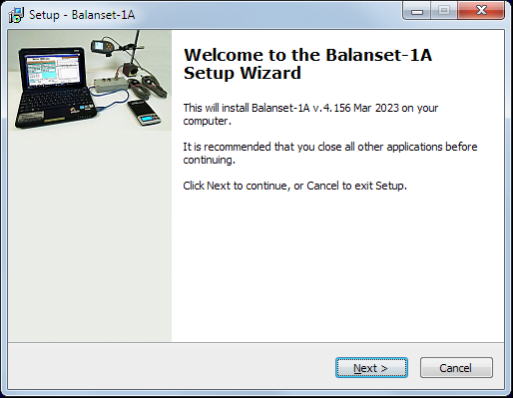
Choose setup folder. Usually the given folder should not be changed.
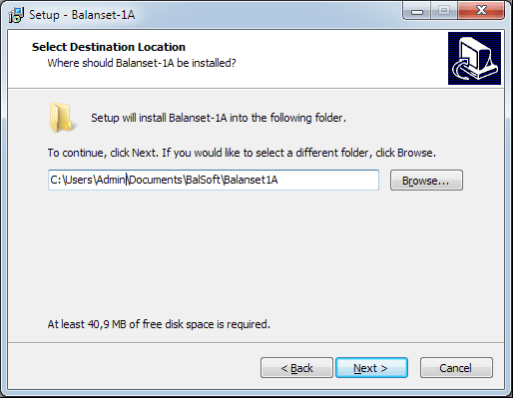
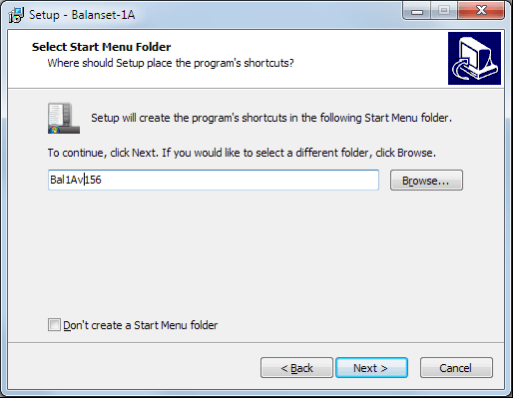
Then the program requires specifying Program group and desktop folders. Press button Next.
स्थापना को अंतिम रूप देना
- ✓Install sensors on the inspected or balanced mechanism (Detailed information about how to install the sensors is given in Annex 1)
- ✓Connect vibration sensors 2 and 3 to the inputs X1 and X2, and phase angle sensor to the input X3 of USB interface unit.
- ✓Connect USB interface unit to the USB-port of the computer.
- ✓एसी पावर सप्लाई का इस्तेमाल करते समय, कंप्यूटर को पावर मेन्स से कनेक्ट करें। पावर सप्लाई को 220 V, 50 Hz से कनेक्ट करें।
- ✓डेस्कटॉप पर "Balanset-1A" शॉर्टकट पर क्लिक करें।.
7. संतुलन सॉफ्टवेयर
7.1. सामान्य
Initial window
"बैलेंससेट-1ए" प्रोग्राम चलाने पर, चित्र 7.1 में दर्शाई गई प्रारंभिक विंडो दिखाई देती है।.

चित्र 7.1. "बैलेंसेट-1ए" की प्रारंभिक खिड़की"
प्रारंभिक विंडो में 9 बटन हैं जिन पर क्लिक करने पर कार्यों के नाम सामने आते हैं।
F1-«About»
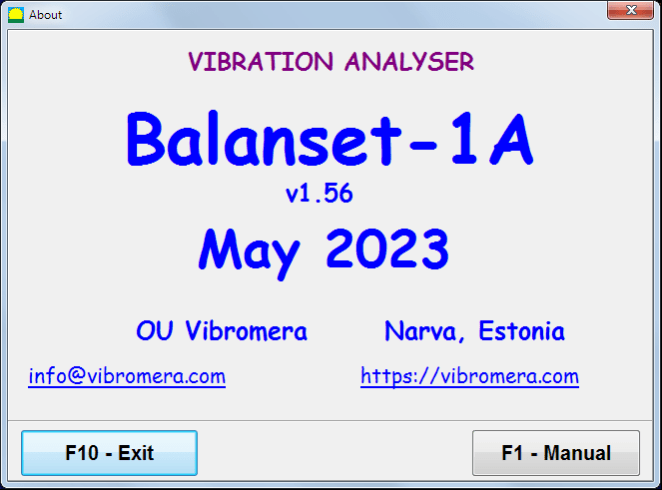
चित्र 7.2. F1-«अबाउट» विंडो
F2-«Single plane», F3-«Two plane»
दबाना ""F2- एकल विमान"" (या F2 कंप्यूटर कीबोर्ड पर फ़ंक्शन कुंजी) चैनल पर माप कंपन का चयन करता है X1.
After clicking this button, the computer display diagram shown in Fig. 7.1 illustrating a process of measuring the vibration only on the first measuring channel (or the balancing process in a single plane).
" बटन दबाने पर"F3-दो विमान"" (या F3 function key on the computer keyboard) selects the mode of vibration measurements on two channels X1 and X2 simultaneously. (Fig. 7.3.)
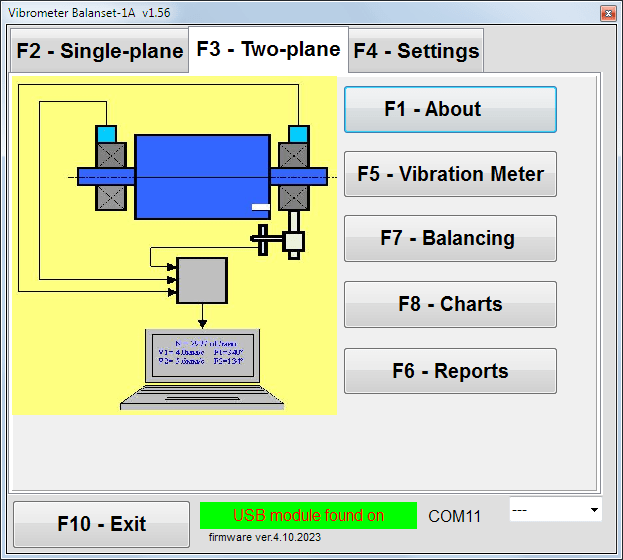
चित्र 7.3. "बैलेंससेट-1ए" की प्रारंभिक विंडो। दो तलीय संतुलन।.
F4 – «सेटिंग्स»
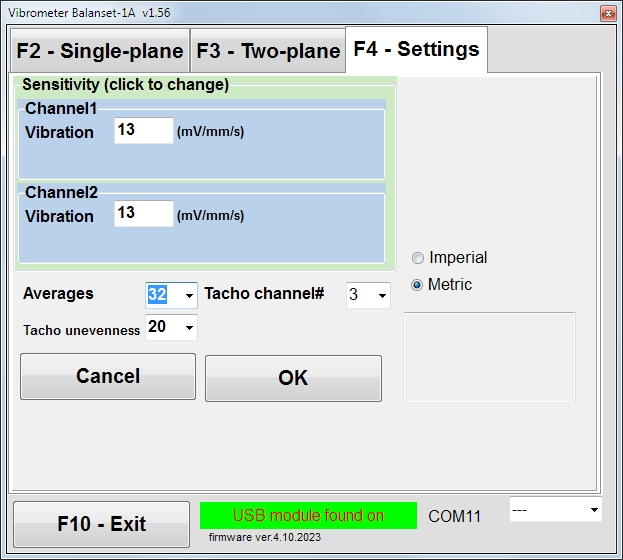
चित्र 7.4. "सेटिंग्स" विंडो
In this window you can change some Balanset-1A settings.
- Sensitivity. The nominal value is 13 mV / mm/s.
Changing the sensitivity coefficients of sensors is required only when replacing sensors!
Attention!
जब आप संवेदनशीलता गुणांक दर्ज करते हैं, तो इसका भिन्नात्मक भाग दशमलव बिंदु (चिह्न ",") द्वारा पूर्णांक भाग से अलग किया जाता है।.
- Averaging - औसत निकालने की संख्या (रोटर के चक्करों की संख्या जिस पर डेटा को अधिक सटीकता के साथ औसत किया जाता है)
- Tacho channel# - चैनल # पर टैकोमीटर कनेक्टेड है। डिफ़ॉल्ट रूप से - तीसरा चैनल।.
- Unevenness - आसन्न टैको पल्स के बीच की अवधि में अंतर, जो ऊपर चेतावनी देता है ""Failure of the tachometer"
- Imperial/Metric - इकाइयों की प्रणाली का चयन करें।.
Com port number is assigned automatically.
F5 – «कंपन मीटर»
Pressing this button (or a function key of F5 कंप्यूटर कीबोर्ड पर बटन दबाने से वर्चुअल वाइब्रेशन मीटर के एक या दो मापन चैनलों पर कंपन मापन मोड सक्रिय हो जाता है, यह बटन की स्थिति पर निर्भर करता है।"F2-एकल-विमान", ""F3-दो-विमान"।.
F6 – «रिपोर्ट»
Pressing this button (or F6 function key on the computer keyboard) switches on the balancing Archive, from which you can print the report with the results of balancing for a specific mechanism (rotor).
F7 – «संतुलन»
इस बटन को दबाने से (या आपके कीबोर्ड पर फ़ंक्शन कुंजी F7 को दबाने से) एक या दो सुधार तलों में संतुलन मोड सक्रिय हो जाता है, यह इस बात पर निर्भर करता है कि बटन दबाकर कौन सा माप मोड चुना गया है।"F2-एकल-विमान", ""F3-दो-विमान"।.
F8 – «चार्ट»
Pressing this button (or F8 कंप्यूटर के कीबोर्ड पर फ़ंक्शन कुंजी दबाने से ग्राफ़िक कंपन मीटर सक्रिय हो जाता है, जिसके कार्यान्वयन से कंपन के आयाम और चरण के डिजिटल मानों के साथ-साथ इसके समय फ़ंक्शन के ग्राफ़िक्स भी डिस्प्ले पर प्रदर्शित होते हैं।.
F10 – «बाहर निकलें»
Pressing this button (or F10 कंप्यूटर के कीबोर्ड पर फ़ंक्शन कुंजी दबाने से "बैलेंससेट-1ए" प्रोग्राम पूरा हो जाता है।.
7.2. "कंपन मीटर""
"में काम करने से पहले"Vibration meter""मोड" में, मशीन पर कंपन सेंसर स्थापित करें और उन्हें क्रमशः यूएसबी इंटरफेस यूनिट के कनेक्टर X1 और X2 से कनेक्ट करें। टैको सेंसर को यूएसबी इंटरफेस यूनिट के इनपुट X3 से कनेक्ट किया जाना चाहिए।.

Fig. 7.5 USB interface unit
टैको कार्य के लिए रोटर की सतह पर परावर्तक टेप लगाएं।

चित्र 7.6. परावर्तक टेप.
Recommendations for the installation and configuration of sensors are given in Annex 1.
वाइब्रेशन मीटर मोड में माप शुरू करने के लिए " बटन पर क्लिक करें"F5 – Vibration Meter"प्रोग्राम की प्रारंभिक विंडो में (चित्र 7.1 देखें)।.
Vibration Meter window appears (see. Fig.7.7)

Fig. 7.7. Vibration meter mode. Wave and Spectrum.
कंपन मापन शुरू करने के लिए बटन पर क्लिक करें ""F9 – भागो"(या फ़ंक्शन कुंजी दबाएँ) F9 on the keyboard).
If ट्रिगर मोड ऑटो यदि जांच की जाती है - तो कंपन माप के परिणाम समय-समय पर स्क्रीन पर प्रदर्शित किए जाएंगे।.
पहले और दूसरे चैनल पर कंपन के एक साथ मापन के मामले में, "शब्दों के नीचे स्थित विंडो"Plane 1"" और ""Plane 2"भरा जाएगा।.
"वाइब्रेशन" मोड में कंपन मापन, फेज एंगल सेंसर को डिस्कनेक्ट करके भी किया जा सकता है। प्रोग्राम की प्रारंभिक विंडो में कुल RMS कंपन का मान (V1s, V2s) will only be displayed.
कंपन मीटर मोड में अगली सेटिंग्स हैं
- आरएमएस कम, हर्ट्ज - समग्र कंपन के आरएमएस की गणना करने के लिए सबसे कम आवृत्ति
- बैंडविड्थ चार्ट में कंपन आवृत्ति बैंडविड्थ
- Averages - माप की सटीकता बढ़ाने के लिए औसत की संख्या
"वाइब्रेशन मीटर" मोड में काम पूरा करने के लिए बटन पर क्लिक करें।"F10 – Exit"और प्रारंभिक विंडो पर वापस लौटें।.

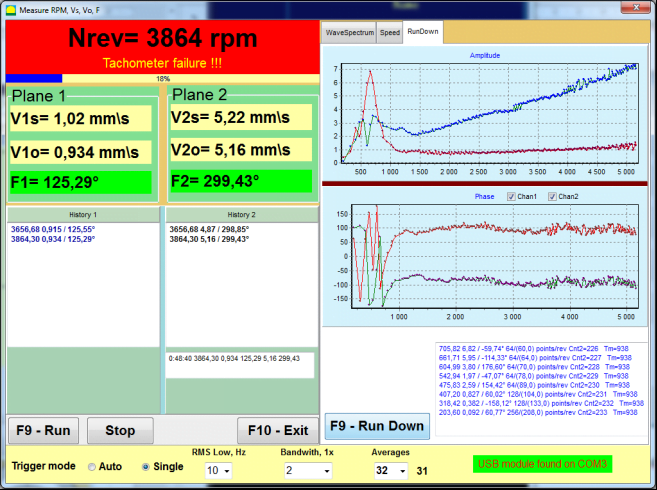
Fig. 7.8. Vibration meter mode. Rotation speed Unevenness, 1x vibration wave form.
Fig. 7.9. Vibration meter mode. Rundown (beta version, no warranty!).
7.3 संतुलन प्रक्रिया
Balancing is performed for mechanisms in good technical condition and correctly mounted. Otherwise, before the balancing the mechanism must be repaired, installed in proper bearings and fixed. Rotor should be cleaned of contaminants that can hinder from balancing procedure.
Before balancing measure vibration in Vibration meter mode (F5 button) to be sure that mainly vibration is 1x vibration.
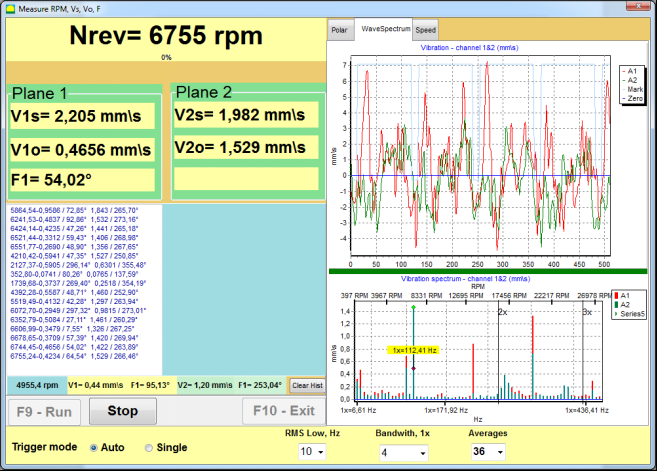
Fig. 7.10. Vibration meter mode. Checking overall (V1s,V2s) and 1x (V1o,V2o) vibration.
यदि समग्र कंपन V1s (V2s) का मान घूर्णन आवृत्ति (1x कंपन) V1o (V2o) पर कंपन के परिमाण के लगभग बराबर है, तो यह माना जा सकता है कि कंपन तंत्र में मुख्य योगदान रोटर के असंतुलन से आता है। यदि समग्र कंपन V1s (V2s) का मान 1x कंपन घटक V1o (V2o) से बहुत अधिक है, तो तंत्र की स्थिति की जाँच करने की अनुशंसा की जाती है - बेयरिंग की स्थिति, आधार पर उसका आरोहण, घूर्णन के दौरान स्थिर भागों और रोटर के बीच कोई संपर्क न हो, आदि।
आपको कंपन मीटर मोड में मापे गए मानों की स्थिरता पर भी ध्यान देना चाहिए - माप प्रक्रिया के दौरान कंपन का आयाम और चरण 10-15% से अधिक भिन्न नहीं होना चाहिए। अन्यथा, यह माना जा सकता है कि तंत्र अनुनाद के निकट क्षेत्र में कार्य कर रहा है। इस स्थिति में, रोटर की घूर्णन गति बदलें, और यदि यह संभव न हो, तो मशीन को नींव पर स्थापित करने की स्थिति बदलें (उदाहरण के लिए, इसे अस्थायी रूप से स्प्रिंग सपोर्ट पर लगाएँ)।
रोटर संतुलन के लिए प्रभाव गुणांक विधि संतुलन (3-रन विधि) का उपयोग किया जाना चाहिए।
Trial runs are done to determine the effect of trial mass on vibration change, mass and place (angle) of installation of correction weights.
First determine the original vibration of a mechanism (first start without weight), and then set the trial weight to the first plane and made the second start. Then, remove the trial weight from the first plane, set in a second plane and made the second start.
The program then calculates and indicates on the screen the weight and location (angle) of installation of correction weights.
When balancing in a single plane (static), the second start is not required.
Trial weight is set to an arbitrary location on the rotor where it is convenient, and then the actual radius is entered in the setup program.
(Position Radius is used only for calculating the unbalance amount in grams * mm)
Important!
- Measurements should be carried out with the constant speed of rotation of the mechanism!
- Correction weights must be installed on the same radius as the trial weights!
परीक्षण भार का द्रव्यमान इस प्रकार चुना जाता है कि उसके स्थापना चरण (> 20-30°) और (20-30%) के बाद कंपन का आयाम महत्वपूर्ण रूप से बदल जाए। यदि परिवर्तन बहुत कम हैं, तो बाद की गणनाओं में त्रुटि बहुत बढ़ जाती है। परीक्षण द्रव्यमान को चरण चिह्न के समान स्थान (समान कोण) पर सुविधाजनक रूप से सेट करें।
परीक्षण भार द्रव्यमान गणना सूत्र
Mt = Mr × Ksupport × Kvibration / (Rt × (N/100)²)
कहाँ:
- मीट्रिक टन - परीक्षण वजन द्रव्यमान, ग्राम
- श्री - रोटर का द्रव्यमान, ग्राम
- केसपोर्ट - समर्थन कठोरता गुणांक (1-5)
- के-कंपन - कंपन स्तर गुणांक (0.5-2.5)
- आर टी - परीक्षण भार स्थापना त्रिज्या, सेमी
- एन - रोटर की गति, आरपीएम
समर्थन कठोरता गुणांक (Ksupport):
- 1.0 - बहुत नरम समर्थन (रबर डैम्पर्स)
- 2.0-3.0 - मध्यम कठोरता (मानक बीयरिंग)
- 4.0-5.0 - कठोर समर्थन (विशाल नींव)
कंपन स्तर गुणांक (Kvibration):
- 0.5 - कम कंपन (5 मिमी/सेकंड तक)
- 1.0 - सामान्य कंपन (5-10 मिमी/सेकंड)
- 1.5 - उच्च कंपन (10-20 मिमी/सेकंड)
- 2.0 - उच्च कंपन (20-40 मिमी/सेकंड)
- 2.5 - अत्यधिक कंपन (>40 मिमी/सेकंड)
🔗 हमारे ऑनलाइन कैलकुलेटर का उपयोग करें:
परीक्षण वजन कैलकुलेटर →⚠️ महत्वपूर्ण!
After each test run trial mass are removed! Correction weights set at an angle calculated from the place of trial weight installation in the direction of rotation of the rotor!
कोण गणना की व्याख्या:
करेक्शन वेट इंस्टॉलेशन एंगल है हमेशा परीक्षण भार स्थापना बिंदु से रोटर घूर्णन की दिशा में गणना की गई।.
- शून्य बिंदु (0°): परीक्षण भार स्थापित करने का सटीक स्थान आपका संदर्भ बिंदु (0 डिग्री) बन जाता है।.
- दिशा: रोटर जिस दिशा में घूमता है, उसी दिशा में कोण को मापें।.
उदाहरण: यदि रोटर दक्षिणावर्त घूमता है, तो परीक्षण भार की स्थिति से दक्षिणावर्त दिशा में कोण मापें।. - व्याख्या: यदि प्रोग्राम किसी कोण को प्रदर्शित करता है 120°, आपको सुधार भार स्थापित करना होगा 120 डिग्री आगे घूर्णन की दिशा में परीक्षण भार की स्थिति।.
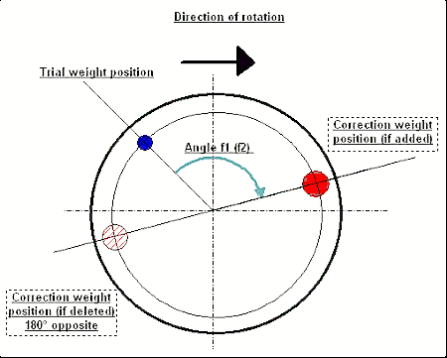
चित्र 7.11. सुधार भार आरोहण.
अनुशंसित!
गतिशील संतुलन करने से पहले, यह सुनिश्चित करना उचित है कि स्थैतिक असंतुलन बहुत अधिक न हो। क्षैतिज अक्ष वाले रोटरों के लिए, रोटर को वर्तमान स्थिति से 90 डिग्री के कोण पर मैन्युअल रूप से घुमाया जा सकता है। यदि रोटर स्थैतिक रूप से असंतुलित है, तो उसे संतुलन की स्थिति में घुमाया जाएगा। रोटर के संतुलन की स्थिति में आने के बाद, रोटर की लंबाई के लगभग मध्य भाग में शीर्ष बिंदु पर संतुलन भार स्थापित करना आवश्यक है। भार इस प्रकार चुना जाना चाहिए कि रोटर किसी भी स्थिति में गति न करे।
इस तरह के पूर्व-संतुलन से अत्यधिक असंतुलित रोटर के प्रथम प्रारंभ में कंपन की मात्रा कम हो जाएगी।
सेंसर स्थापना और माउंटिंग
वीibration sensor must be installed on the machine in the selected measuring point and connected to the input X1 of the USB interface unit.
दो माउंटिंग कॉन्फ़िगरेशन हैं:
- चुम्बक
- Threaded studs M4
Optical tacho sensor should be connected to the input X3 of the USB interface unit. Furthermore, for use of this sensor a special reflecting mark should be applied on surface of a rotor.
📏 ऑप्टिकल सेंसर इंस्टॉलेशन संबंधी आवश्यकताएँ
- ✓रोटर सतह से दूरी: 50-500 मिमी (सेंसर मॉडल पर निर्भर करता है)
- ✓परावर्तक टेप की चौड़ाई: न्यूनतम 1-1.5 सेमी (गति और त्रिज्या पर निर्भर करता है)
- ✓अभिविन्यास: रोटर सतह के लंबवत
- ✓माउंटिंग: स्थिर स्थिति के लिए चुंबकीय स्टैंड या क्लैंप का उपयोग करें
- ✓सीधी धूप से बचें या सेंसर/टेप पर उज्ज्वल कृत्रिम प्रकाश
💡 टेप चौड़ाई गणना: इष्टतम प्रदर्शन के लिए, टेप की चौड़ाई की गणना निम्न का उपयोग करके करें:
एल ≥ (एन × आर)/30000 ≥ 1.0-1.5 सेमी
जहां: L - टेप की चौड़ाई (सेमी), N - रोटर की गति (आरपीएम), R - टेप की त्रिज्या (सेमी)
Detailed requirements on site selection of the sensors and their attachment to the object when balancing are set out in Annex 1.
7.4 एकल तल संतुलन
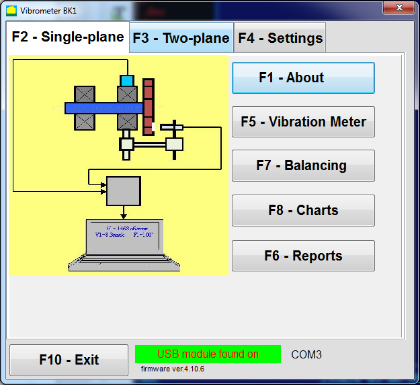
चित्र 7.12. "एकल तल संतुलन"
संतुलन संग्रह
"कार्यक्रम पर काम शुरू करने के लिए"Single-Plane balancing"" मोड पर क्लिक करें ""F2-Single-plane"" बटन दबाएं (या कंप्यूटर कीबोर्ड पर F2 कुंजी दबाएं)।.
फिर " पर क्लिक करें"F7 – Balancing"" बटन, जिसके बाद Single Plane balancing archive window will appear, in which the balancing data will be saved (see Fig. 7.13).

Fig. 7.13 The window for selecting the balancing archive in single plane.
In this window, you need to enter data on the name of the rotor (Rotor name), place of rotor installation (Place), tolerances for vibration and residual imbalance (Tolerance), date of measurement. This data is stored in a database. Also, a folder Arc### is created in, where ### is the number of the archive in which the charts, a report file, etc. will be saved. After the balancing is completed, a report file will be generated that can be edited and printed in the built-in editor.
आवश्यक डेटा दर्ज करने के बाद, आपको " पर क्लिक करना होगा"F10-OK"" बटन, जिसके बाद ""Single-Plane balancing""खिड़की खुल जाएगी (चित्र 7.13 देखें)"
Balancing settings (1-plane)
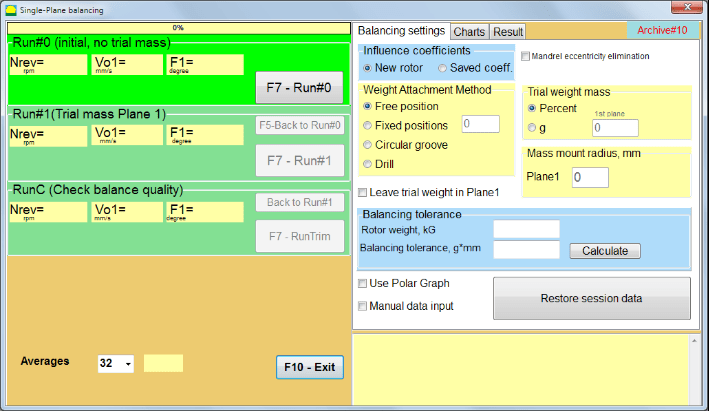
Fig. 7.14. Single plane. Balancing settings
इस विंडो के बाईं ओर कंपन माप के डेटा और माप नियंत्रण बटन प्रदर्शित होते हैं।"Run # 0", "Run # 1", "RunTrim".
इस विंडो के दाईं ओर तीन टैब हैं:
- Balancing settings
- Charts
- Result
""Balancing settings""टैब" का उपयोग बैलेंसिंग सेटिंग्स दर्ज करने के लिए किया जाता है:
- ""प्रभाव गुणांक"" -
- "New Rotor"नए रोटर के संतुलन का चयन, जिसके लिए कोई संग्रहीत संतुलन गुणांक नहीं हैं और सुधार भार के द्रव्यमान और स्थापना कोण को निर्धारित करने के लिए दो परीक्षणों की आवश्यकता होती है।.
- "Saved coeff."रोटर री-बैलेंसिंग का चयन, जिसके लिए बैलेंसिंग गुणांक सहेजे गए हैं और सुधारात्मक वजन के वजन और स्थापना कोण को निर्धारित करने के लिए केवल एक ही रन की आवश्यकता होती है।.
- ""परीक्षण भार द्रव्यमान"" -
- "Percent""- सुधारात्मक वजन की गणना परीक्षण वजन के प्रतिशत के रूप में की जाती है।".
- "Gram"परीक्षण भार का ज्ञात द्रव्यमान दर्ज किया जाता है और सुधारात्मक भार का द्रव्यमान परिकलित किया जाता है। grams or in oz for Imperial system.
⚠️ ध्यान दें! यदि इसका उपयोग करना आवश्यक हो तो ""Saved coeff."प्रारंभिक संतुलन के दौरान आगे के कार्य के लिए, परीक्षण भार को ग्राम या औंस में दर्ज किया जाना चाहिए, न कि % में। तराजू डिलीवरी पैकेज में शामिल हैं।.
- ""वजन लगाने की विधि""
- "Free position"रोटर की परिधि पर किसी भी कोणीय स्थिति में भार स्थापित किए जा सकते हैं।.
- "Fixed position"रोटर पर निश्चित कोणीय स्थितियों में भार स्थापित किया जा सकता है, उदाहरण के लिए, ब्लेड या छेदों पर (उदाहरण के लिए 12 छेद – 30 डिग्री), आदि। निश्चित स्थितियों की संख्या उपयुक्त फ़ील्ड में दर्ज की जानी चाहिए। संतुलन के बाद, प्रोग्राम स्वचालित रूप से भार को दो भागों में विभाजित करेगा और उन स्थितियों की संख्या बताएगा जिन पर प्राप्त द्रव्यमान को स्थापित करना आवश्यक है।.
- "Circular groove"ग्राइंडिंग व्हील को संतुलित करने के लिए उपयोग किया जाता है। इस मामले में असंतुलन को दूर करने के लिए 3 काउंटरवेट का उपयोग किया जाता है।
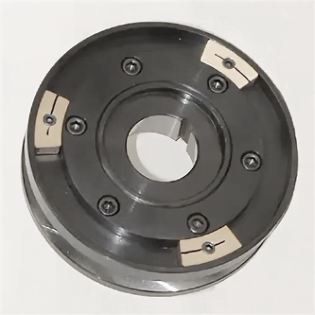
Fig. 7.17 Grinding wheel balancing with 3 counterweights
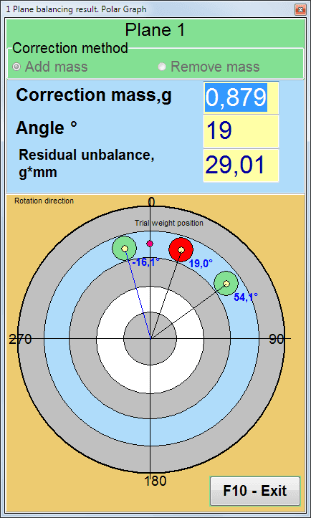
Fig. 7.18 Grinding wheel balancing. Polar graph.

Fig. 7.15. Result tab. Fixed position of correction weight mounting.
Z1 और Z2 - स्थापित सुधारात्मक भारों की स्थितियाँ, घूर्णन दिशा के अनुसार Z1 स्थिति से गणना की जाती हैं। Z1 वह स्थिति है जहाँ परीक्षण भार स्थापित किया गया था।
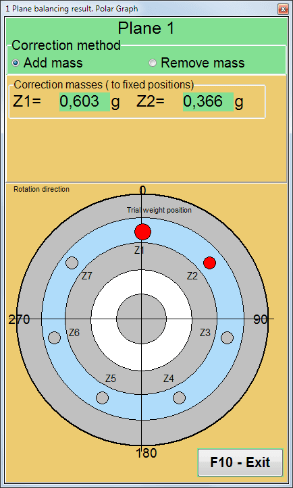
Fig. 7.16 Fixed positions. Polar diagram.
- "Mass mount radius, mm""- "प्लेन 1" - पहले तल में परीक्षण भार की त्रिज्या। संतुलन के बाद अवशिष्ट असंतुलन के लिए सहनशीलता के अनुपालन को निर्धारित करने के लिए प्रारंभिक और अवशिष्ट असंतुलन के परिमाण की गणना करना आवश्यक है।.
- "Leave trial weight in Plane1.""आमतौर पर संतुलन प्रक्रिया के दौरान परीक्षण भार को हटा दिया जाता है। लेकिन कुछ मामलों में इसे हटाना असंभव होता है, ऐसे में गणना में परीक्षण भार के द्रव्यमान को ध्यान में रखने के लिए आपको इसमें एक चेक मार्क लगाना होगा।".
- "मैनुअल डेटा इनपुट"" - इसका उपयोग विंडो के बाईं ओर उपयुक्त फ़ील्ड में कंपन मान और चरण को मैन्युअल रूप से दर्ज करने और स्विच करते समय सुधार भार के द्रव्यमान और स्थापना कोण की गणना करने के लिए किया जाता है।"Results"" टैब
- बटन ""Restore session data"बैलेंसिंग के दौरान, मापा गया डेटा session1.ini फ़ाइल में सहेजा जाता है। यदि कंप्यूटर हैंग होने या अन्य कारणों से माप प्रक्रिया बाधित हो जाती है, तो इस बटन पर क्लिक करके आप माप डेटा को पुनर्स्थापित कर सकते हैं और रुकावट के क्षण से बैलेंसिंग जारी रख सकते हैं।.
- Mandrel eccentricity elimination (Index balancing) Balancing with additional start to eliminate the influence of the eccentricity of the mandrel (balancing arbor). Mount the rotor alternately at 0° and 180° relative to the. Measure the unbalances in both positions.
- Balancing tolerance Entering or calculating residual imbalance tolerances in g x mm (G-classes)
- Use Polar Graph Use polar graph to display balancing results
1-plane Balancing. New rotor
जैसा कि ऊपर उल्लेख किया गया है, ""New Rotor""संतुलन के लिए दो परीक्षण रन और बैलेंसिंग मशीन का कम से कम एक ट्रिम रन आवश्यक है।".
Run#0 (Initial run)
बैलेंसिंग रोटर पर सेंसर लगाने और सेटिंग पैरामीटर दर्ज करने के बाद, रोटर रोटेशन को चालू करना आवश्यक है और जब यह कार्यशील गति तक पहुँच जाए, तो " बटन दबाएँ।"Run#0"माप शुरू करने के लिए " बटन दबाएं।"Charts"दाएँ पैनल में एक टैब खुलेगा, जहाँ कंपन का तरंगरूप और स्पेक्ट्रम दिखाया जाएगा। टैब के निचले भाग में एक इतिहास फ़ाइल रखी जाती है, जिसमें समय संदर्भ के साथ सभी आरंभों के परिणाम सहेजे जाते हैं। डिस्क पर, यह फ़ाइल संग्रह फ़ोल्डर में memo.txt नाम से सहेजी जाती है।
Attention!
Before starting the measurement, it is necessary to turn on the rotation of the rotor of the balancing machine (Run#0) and make sure that the rotor speed is stable.
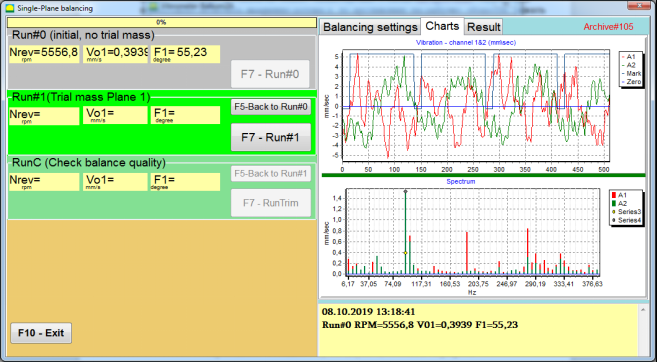
Fig. 7.19. Balancing in one plane. Initial run (Run#0). Charts Tab
After measurement process finished, in the Run#0 बाएं पैनल में अनुभाग में माप के परिणाम दिखाई देते हैं - रोटर गति (आरपीएम), आरएमएस (Vo1) और 1x कंपन का चरण (F1)।.
""F5-Back to Run#0"" बटन (या F5 फ़ंक्शन कुंजी) का उपयोग Run#0 अनुभाग पर वापस जाने के लिए किया जाता है और यदि आवश्यक हो, तो कंपन मापदंडों को मापने को दोहराने के लिए किया जाता है।.
Run#1 (Trial mass Plane 1)
"खंड में कंपन मापदंडों का मापन शुरू करने से पहले"Run#1 (Trial mass Plane 1), परीक्षण भार को तदनुसार स्थापित किया जाना चाहिए।"Trial weight mass"" मैदान।.
The goal of installing a trial weight is to evaluate how the vibration of the rotor changes when a known weight is installed at a known place (angle). Trial weight must changes the vibration amplitude by either 30% lower or higher of initial amplitude or change phase by 30 degrees or more of initial phase.
यदि इसका उपयोग करना आवश्यक हो तो ""Saved coeff."आगे के कार्य के लिए संतुलन स्थापित करने हेतु, परीक्षण भार की स्थापना का स्थान (कोण) परावर्तक चिह्न के स्थान (कोण) के समान होना चाहिए।.
संतुलन मशीन के रोटर का घूर्णन पुनः चालू करें और सुनिश्चित करें कि इसकी घूर्णन आवृत्ति स्थिर है। फिर " पर क्लिक करें।"F7-Run#1"" बटन दबाएं (या कंप्यूटर कीबोर्ड पर F7 कुंजी दबाएं)।.
संबंधित विंडो में माप के बाद ""Run#1 (Trial mass Plane 1)"" अनुभाग, रोटर गति (आरपीएम) को मापने के परिणाम, साथ ही साथ दिखाई देने वाले 1x कंपन के आरएमएस घटक (Vо1) और चरण (F1) का मान।.
साथ ही, ""Result"विंडो के दाईं ओर " टैब खुलता है।.
This tab displays the results of calculating the mass and angle of corrective weight, which must be installed on the rotor to compensate imbalance.
इसके अलावा, ध्रुवीय निर्देशांक प्रणाली का उपयोग करने के मामले में, प्रदर्शन सुधार भार का द्रव्यमान मान (M1) और स्थापना कोण (f1) दिखाता है।
इस मामले में ""Fixed positions""स्थितियों की संख्या (Zi, Zj) और परीक्षण भार विभाजित द्रव्यमान दिखाया जाएगा।".
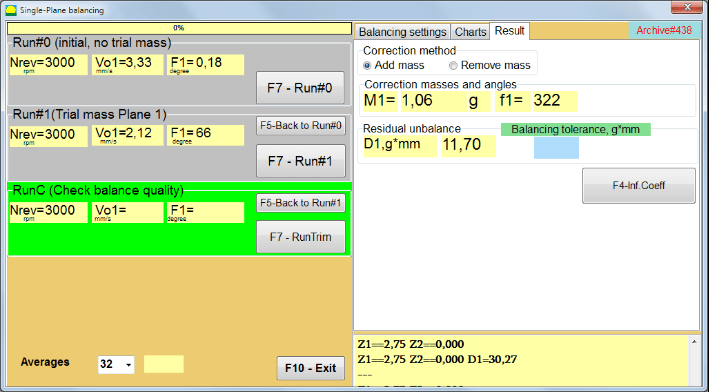
Fig. 7.20. Balancing in one plane. Run#1 and balancing result.
If ध्रुवीय ग्राफ is checked polar diagram will be shown.
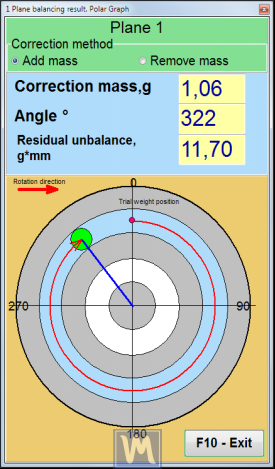
चित्र 7.21. संतुलन का परिणाम. ध्रुवीय ग्राफ.
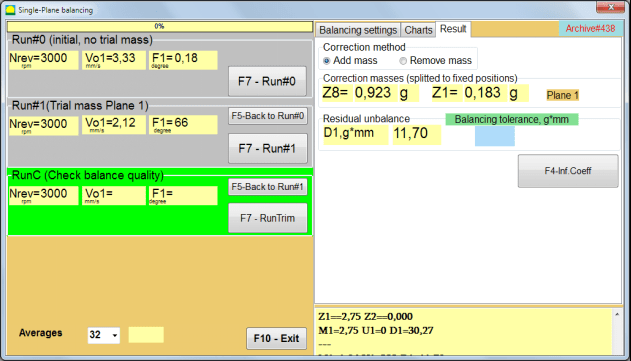
Fig. 7.22. The result of balancing. Weight splitted (fixed positions)
इसके अलावा यदि ""ध्रुवीय ग्राफ""जांच की गई, ध्रुवीय ग्राफ दिखाया जाएगा।".
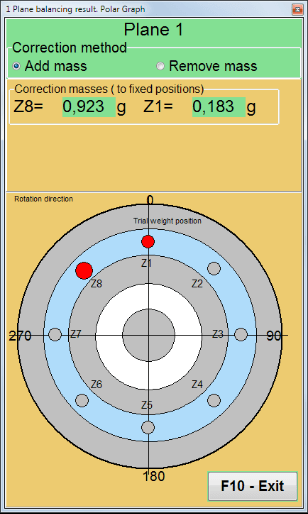
चित्र 7.23. स्थिर स्थितियों पर विभाजित भार. ध्रुवीय ग्राफ
⚠️ ध्यान दें!
- दूसरे चरण में माप प्रक्रिया पूरी करने के बाद (""Run#1 (Trial mass Plane 1)"संतुलन मशीन के संचालन के दौरान, घूर्णन को रोकना और स्थापित परीक्षण भार को हटाना आवश्यक है। फिर परिणाम टैब डेटा के अनुसार रोटर पर सुधारात्मक भार स्थापित करें (या हटाएँ)।.
यदि परीक्षण भार नहीं हटाया गया है, तो आपको " पर स्विच करना होगा"Balancing settings"टैब दबाएं और चेकबॉक्स चालू करें।"Leave trial weight in Plane1"फिर वापस " पर स्विच करें"Result"" टैब। सुधार भार का वजन और स्थापना कोण स्वचालित रूप से पुनर्गणना किए जाते हैं।.
- सुधारात्मक भार की कोणीय स्थिति परीक्षण भार की स्थापना के स्थान से निर्धारित की जाती है। कोण के संदर्भ की दिशा रोटर के घूर्णन की दिशा के साथ मेल खाती है।
- इस मामले में ""Fixed position""- 1st position (Z1), coincides with the place of installation of the trial weight. The counting direction of the position number is in the direction of rotation of the rotor.
- डिफ़ॉल्ट रूप से रोटर में सुधारात्मक भार जोड़ा जाएगा। यह " में सेट किए गए लेबल द्वारा इंगित किया गया है।"Add"" फ़ील्ड। यदि वज़न हटा रहे हैं (उदाहरण के लिए, ड्रिलिंग द्वारा), तो आपको " में एक निशान लगाना होगा।"Delete""क्षेत्र, जिसके बाद सुधार भार की कोणीय स्थिति स्वचालित रूप से 180º से बदल जाएगी।.
ऑपरेटिंग विंडो में संतुलन रोटर पर सुधार भार स्थापित करने के बाद, रनसी (ट्रिम) करना और निष्पादित संतुलन की प्रभावशीलता का मूल्यांकन करना आवश्यक है।
RunC (Check balance quality)
⚠️ ध्यान दें! Before starting the measurement on the RunC, it is necessary to turn on the rotation of the rotor of the machine and make sure that it has entered the operating mode (stable rotation frequency).
कंपन मापन करने के लिए"RunC (Check balance quality)"" अनुभाग पर क्लिक करें ""F7 – RunTrim"" बटन दबाएं (या कीबोर्ड पर F7 कुंजी दबाएं)।.
माप प्रक्रिया के सफलतापूर्वक पूरा होने पर, ""RunC (Check balance quality)"बाएं पैनल में " अनुभाग में, रोटर गति (आरपीएम) को मापने के परिणाम, साथ ही 1x कंपन के आरएमएस घटक (Vo1) और चरण (F1) का मान दिखाई देता है।.
"में"Result"" टैब" पर क्लिक करने पर, अतिरिक्त सुधारात्मक भार के द्रव्यमान और स्थापना कोण की गणना के परिणाम प्रदर्शित होते हैं।.
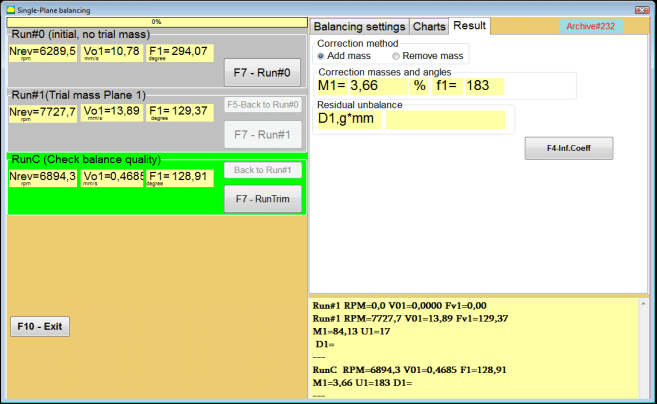
Fig. 7.24. Balancing in one plane. Performing a RunTrim. Result Tab
This weight can be added to the correction weight that is already mounted on the rotor to compensate for the residual imbalance. In addition, the residual rotor unbalance achieved after balancing is displayed in the lower part of this window.
In the case when the amount of residual vibration and / or residual unbalance of the balanced rotor meets the tolerance requirements established in the technical documentation, the balancing process can be completed.
Otherwise, the balancing process may continue. This allows the method of successive approximations to correct possible errors that may occur during the installation (removal) of the corrective weight on a balanced rotor.
बैलेंसिंग रोटर पर बैलेंसिंग प्रक्रिया जारी रखते समय, अतिरिक्त सुधारात्मक द्रव्यमान को स्थापित (हटाना) आवश्यक है, जिसके पैरामीटर " अनुभाग में दर्शाए गए हैं।"Correction masses and angles".
Influence coefficients (1-plane)
""F4-Inf.Coeff"" बटन में ""Result"कैलिब्रेशन रन के परिणामों से गणना किए गए रोटर संतुलन गुणांक (प्रभाव गुणांक) को देखने और कंप्यूटर मेमोरी में संग्रहीत करने के लिए "टैब" का उपयोग किया जाता है।.
जब इसे दबाया जाता है, तो ""Influence coefficients (single plane)"कंप्यूटर डिस्प्ले पर एक विंडो दिखाई देती है, जिसमें अंशांकन (परीक्षण) रन के परिणामों से गणना किए गए संतुलन गुणांक प्रदर्शित होते हैं। यदि इस मशीन के बाद के संतुलन के दौरान इसका उपयोग किया जाना है, तो..."Saved coeff.""इस मोड में, इन गुणांकों को कंप्यूटर मेमोरी में संग्रहीत किया जाना चाहिए।".
ऐसा करने के लिए, " पर क्लिक करें"F9 - सहेजें"" बटन पर क्लिक करें और दूसरे पृष्ठ पर जाएं ""प्रभाव गुणांक. पुरालेख. एकल तल."

Fig. 7.25. Balancing coefficients in the 1st plane
फिर आपको इस मशीन का नाम " में दर्ज करना होगा"Rotor"" कॉलम पर क्लिक करें ""F2-Save"कंप्यूटर पर निर्दिष्ट डेटा सहेजने के लिए "बटन" दबाएं।.
फिर आप " बटन दबाकर पिछली विंडो पर वापस जा सकते हैं।"F10-Exit"" बटन (या कंप्यूटर कीबोर्ड पर F10 फ़ंक्शन कुंजी)।.
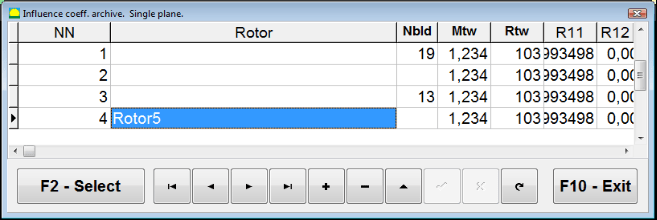
चित्र 7.26. "प्रभाव गुणांक संग्रह. एकल तल.""
Balancing report
सभी डेटा सहेजे जाने और बैलेंसिंग रिपोर्ट तैयार होने के बाद, आप बिल्ट-इन एडिटर में रिपोर्ट देख और संपादित कर सकते हैं। विंडो में ""एक ही तल में संग्रह को संतुलित करना"" (चित्र 7.9) बटन दबाएँ ""F9 -Report"बैलेंसिंग रिपोर्ट एडिटर तक पहुंचने के लिए।.
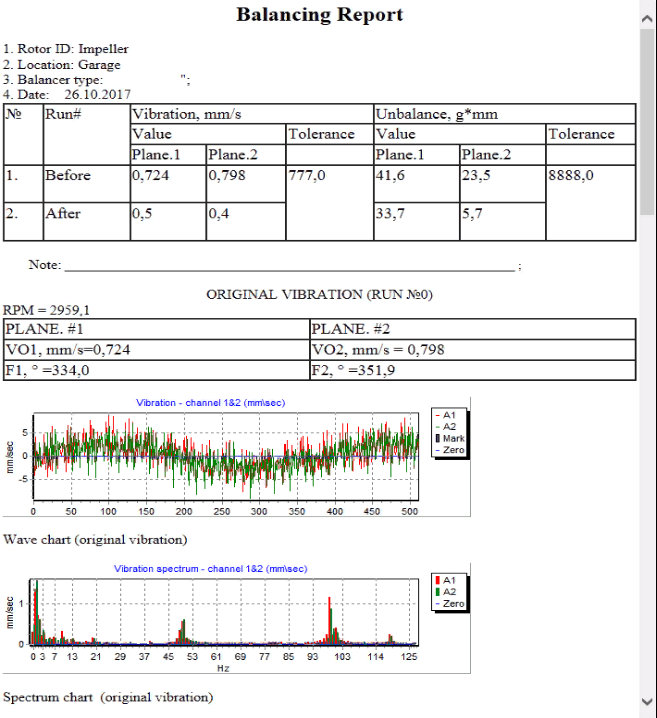
चित्र 7.27. संतुलन रिपोर्ट.
1 तल में सहेजे गए प्रभाव गुणांकों के साथ सहेजे गए गुणांक संतुलन प्रक्रिया
मापन प्रणाली की स्थापना (प्रारंभिक डेटा का इनपुट)
Saved coeff. balancing can be performed on a machine for which balancing coefficients have already been determined and entered into the computer memory.
⚠️ ध्यान दें! When balancing with saved coefficients, the vibration sensor and the phase angle sensor must be installed in the same way as during the initial balancing.
Input of the initial data for Saved coeff. balancing (जैसा कि प्राथमिक के मामले में है)"New rotor"संतुलन की शुरुआत होती है"Single plane balancing. Balancing settings.".
इस मामले में, ""Influence coefficients"" अनुभाग में, " का चयन करें"Saved coeff"" आइटम। इस मामले में, " का दूसरा पृष्ठ"Influence coeff. archive. Single plane.जो सहेजे गए संतुलन गुणांकों का एक संग्रह संग्रहीत करता है।.
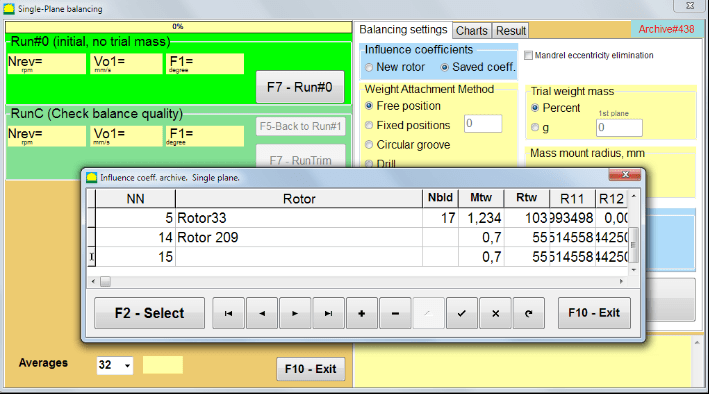
Fig. 7.28. Balancing with saved influence coefficients in 1 plane
इस संग्रह की तालिका में "►" या "◄" नियंत्रण बटनों का उपयोग करके आगे बढ़ते हुए, आप अपनी रुचि की मशीन के संतुलन गुणांकों के साथ वांछित रिकॉर्ड का चयन कर सकते हैं। फिर, वर्तमान मापों में इस डेटा का उपयोग करने के लिए, " बटन दबाएँ।"F2 – Select"" बटन।.
उसके बाद, " की अन्य सभी विंडो की सामग्री"Single plane balancing. Balancing settings."" स्वचालित रूप से भर दिए जाते हैं।.
After completing the input of the initial data, you can begin to measure.
सहेजे गए प्रभाव गुणांकों के साथ संतुलन के दौरान माप
Balancing with saved influence coefficients requires only one initial run and at least one test run of the balancing machine.
⚠️ ध्यान दें! Before starting the measurement, it is necessary to turn on the rotation of the rotor and make sure that rotating frequency is stable.
कंपन मापदंडों के मापन को पूरा करने के लिए"Run#0 (Initial, no trial mass)"" अनुभाग, दबाएँ ""F7 – Run#0"(या कंप्यूटर कीबोर्ड पर F7 कुंजी दबाएं)।.
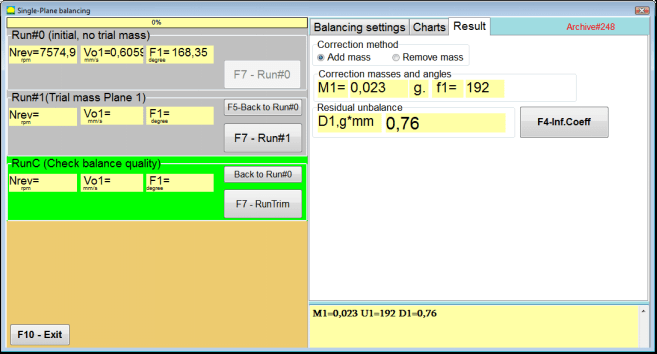
Fig. 7.29. Balancing with saved influence coefficients in one plane. Results after one run.
"के संबंधित क्षेत्रों में"Run#0"" अनुभाग में, रोटर गति (आरपीएम) को मापने के परिणाम, आरएमएस घटक (Vо1) का मान और 1x कंपन का चरण (F1) दिखाई देता है।.
साथ ही, ""Result"" टैब में सुधारात्मक भार के द्रव्यमान और कोण की गणना के परिणाम प्रदर्शित होते हैं, जिसे असंतुलन की भरपाई के लिए रोटर पर स्थापित किया जाना चाहिए।.
इसके अलावा, ध्रुवीय निर्देशांक प्रणाली का उपयोग करने के मामले में, प्रदर्शन द्रव्यमान मूल्यों और सुधार भार के स्थापना कोणों को दर्शाता है।
In the case of splitting of the corrective weight on the fixed positions, the numbers of the positions of the balancing rotor and the mass of weight that need to be installed on them are displayed.
Further, the balancing process is carried out in accordance with the recommendations set out in section 7.4.2. for primary balancing.
Mandrel eccentricity elimination (Index balancing)
If during balancing the rotor is installed in a cylindrical mandrel, then the eccentricity of the mandrel may introduce an additional error. To eliminate this error, the rotor should be deployed in the mandrel 180 degrees and carry out an additional start. This is called index balancing.
To carry out index balancing, a special option is provided in the Balanset-1A program. When checked Mandrel eccentricity elimination an additional RunEcc section appears in the balancing window.

Fig. 7.30. The working window for Index balancing.
After running Run # 1 (Trial mass Plane 1), a window will appear
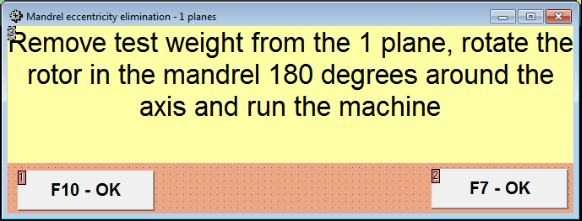
Fig. 7.31 Index balancing attention window.
रोटर को 180° घुमाकर स्थापित करने के बाद, रन Ecc पूरा करना होगा। प्रोग्राम स्वचालित रूप से मैंड्रेल की उत्केन्द्रता को प्रभावित किए बिना वास्तविक रोटर असंतुलन की गणना करेगा।
7.5 दो तल संतुलन
Before starting work in the Two plane balancing mode, it is necessary to install vibration sensors on the machine body at the selected measurement points and connect them to the inputs X1 and X2 of the measuring unit, respectively.
An optical phase angle sensor must be connected to input X3 of the measuring unit. In addition, to use this sensor, a reflective tape must be glued onto the accessible rotor surface of the balancing machine.
Detailed requirements for choosing the installation location of sensors and their mounting at the facility during balancing are set out in Appendix 1.
कार्यक्रम पर काम ""Two plane balancing""मोड प्रोग्राम की मुख्य विंडो से शुरू होता है।".
पर क्लिक करें ""F3-Two plane"" बटन दबाएं (या कंप्यूटर कीबोर्ड पर F3 कुंजी दबाएं)।.
इसके अलावा, "एफ7 - बैलेंसिंग" बटन पर क्लिक करें, जिसके बाद कंप्यूटर डिस्प्ले पर एक वर्किंग विंडो दिखाई देगी (चित्र 7.13 देखें), दो तलों में संतुलन करते समय डेटा को सहेजने के लिए संग्रह का चयन करें।.
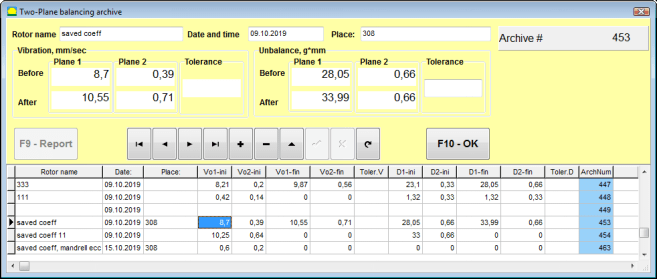
Fig. 7.32 Two plane balancing archive window.
इस विंडो में आपको संतुलित रोटर का डेटा दर्ज करना होगा। " बटन दबाने के बाद"F10-OK"" बटन दबाने पर एक बैलेंसिंग विंडो दिखाई देगी।.
Balancing settings (2-plane)
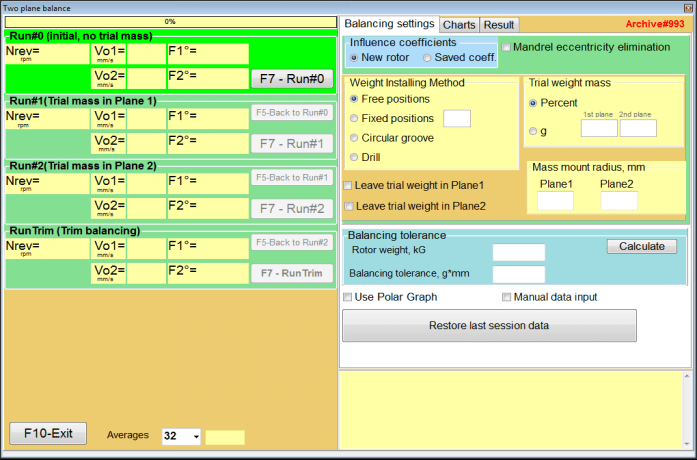
Fig. 7.33. Balancing in two planes window.
खिड़की के दाहिनी ओर ""Balancing settings"बैलेंसिंग से पहले सेटिंग्स दर्ज करने के लिए टैब।.
- Influence coefficients - नए रोटर को संतुलित करना या संग्रहित प्रभाव गुणांकों (संतुलन गुणांकों) का उपयोग करके संतुलन स्थापित करना।
- Mandrel eccentricity elimination - मैंड्रेल की विलक्षणता के प्रभाव को समाप्त करने के लिए अतिरिक्त स्टार्ट के साथ संतुलन स्थापित करना
- Weight Attachment Method - रोटर की परिधि पर किसी भी स्थान पर या किसी निश्चित स्थिति में सुधारात्मक भार स्थापित करना। भार हटाते समय ड्रिलिंग के लिए गणना करना।.
- "Free position"रोटर की परिधि पर किसी भी कोणीय स्थिति में भार स्थापित किए जा सकते हैं।.
- "Fixed position"रोटर पर निश्चित कोणीय स्थितियों में भार स्थापित किया जा सकता है, उदाहरण के लिए, ब्लेड या छेदों पर (उदाहरण के लिए 12 छेद – 30 डिग्री), आदि। निश्चित स्थितियों की संख्या उपयुक्त फ़ील्ड में दर्ज की जानी चाहिए। संतुलन के बाद, प्रोग्राम स्वचालित रूप से भार को दो भागों में विभाजित करेगा और उन स्थितियों की संख्या बताएगा जिन पर प्राप्त द्रव्यमान को स्थापित करना आवश्यक है।.
- Trial weight mass - परीक्षण भार
- Leave trial weight in Plane1 / Plane2 संतुलन बनाते समय परीक्षण भार को हटा दें या वहीं छोड़ दें।.
- Mass mount radius, mm - परीक्षण और सुधारात्मक भार लगाने की त्रिज्या
- Balancing tolerance ग्राम-मिमी में अवशिष्ट असंतुलन सहनशीलता दर्ज करना या उसकी गणना करना
- Use Polar Graph - संतुलन परिणामों को प्रदर्शित करने के लिए ध्रुवीय ग्राफ का उपयोग करें
- मैनुअल डेटा इनपुट - संतुलन भार की गणना के लिए मैन्युअल डेटा प्रविष्टि
- Restore last session data - संतुलन प्रक्रिया जारी रखने में विफलता की स्थिति में पिछले सत्र के माप डेटा की पुनर्प्राप्ति।.
2 planes balancing. New rotor
मापन प्रणाली की स्थापना (प्रारंभिक डेटा का इनपुट)
Input of the initial data for the New rotor balancing में ""दो विमानों का संतुलन. सेटिंग्स".
इस मामले में, ""Influence coefficients"" अनुभाग में, " का चयन करें"New rotor"" वस्तु।.
इसके अलावा, अनुभाग में ""Trial weight mass"आपको परीक्षण भार के द्रव्यमान की माप की इकाई का चयन करना होगा।"Gram"" या ""Percent".
माप की इकाई का चयन करते समय ""Percent"सुधारात्मक भार के द्रव्यमान की सभी आगे की गणनाएँ परीक्षण भार के द्रव्यमान के सापेक्ष प्रतिशत के रूप में की जाएंगी।.
" का चयन करते समय"Gram""माप की इकाई ग्राम में है, सुधारात्मक भार के द्रव्यमान की सभी आगे की गणनाएँ ग्राम में की जाएँगी। फिर शिलालेख के दाईं ओर स्थित विंडो में दर्ज करें।""Gram"रोटर पर स्थापित किए जाने वाले परीक्षण भारों का द्रव्यमान।.
⚠️ ध्यान दें! यदि इसका उपयोग करना आवश्यक हो तो ""Saved coeff."प्रारंभिक संतुलन के दौरान आगे के कार्य के लिए, परीक्षण भारों का द्रव्यमान दर्ज किया जाना चाहिए। grams.
फिर " का चयन करें"Weight Attachment Method" - "Circum"" या ""Fixed position".
यदि आप " का चयन करते हैं"Fixed position"आपको पदों की संख्या दर्ज करनी होगी।.
Calculation of tolerance for residual imbalance (Balancing tolerance)
अवशिष्ट असंतुलन (संतुलन सहिष्णुता) के लिए सहनशीलता की गणना ISO 1940 कंपन में वर्णित प्रक्रिया के अनुसार की जा सकती है। स्थिर (दृढ़) अवस्था में रोटरों के लिए संतुलन गुणवत्ता आवश्यकताएँ। भाग 1. संतुलन सहिष्णुता का विनिर्देशन और सत्यापन।

Fig. 7.34. Balancing tolerance calculation window
Initial run (Run#0)
जब दो तलों में संतुलन स्थापित करते समय ""New rotor""मोड" में, संतुलन के लिए तीन कैलिब्रेशन रन और बैलेंसिंग मशीन का कम से कम एक टेस्ट रन आवश्यक होता है।.
मशीन के पहले प्रारंभ में कंपन माप " में किया जाता है"Two plane balance""कार्यशील विंडो में""Run#0"" अनुभाग।.
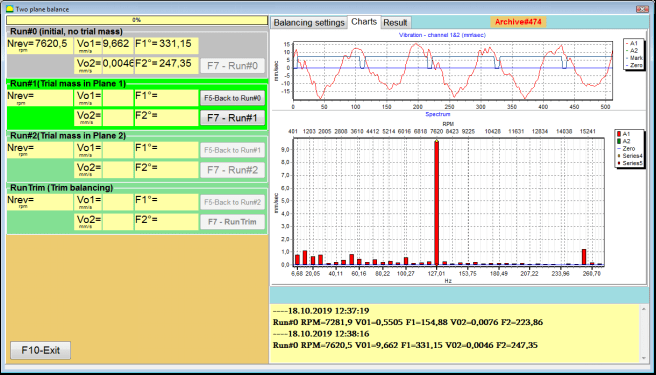
चित्र 7.35. प्रारंभिक रन के बाद दो तलों में संतुलन पर माप परिणाम।
⚠️ ध्यान दें! माप शुरू करने से पहले, संतुलन मशीन (पहले रन) के रोटर के रोटेशन को चालू करना और यह सुनिश्चित करना आवश्यक है कि यह स्थिर गति के साथ ऑपरेटिंग मोड में प्रवेश कर गया है।
To measure vibration parameters in the Run#0 इस सेक्शन में, " पर क्लिक करें"F7 – Run#0"" बटन दबाएं (या कंप्यूटर कीबोर्ड पर F7 कुंजी दबाएं)
रोटर गति (आरपीएम), आरएमएस मान (वीओ1, वीओ2) और 1x कंपन के चरण (एफ1, एफ2) को मापने के परिणाम संबंधित विंडो में दिखाई देते हैं Run#0 section.
Run#1.Trial mass in Plane1
कंपन मापदंडों को मापना शुरू करने से पहले ""Run#1.Trial mass in Plane1"" अनुभाग में, आपको संतुलन मशीन के रोटर का घूर्णन रोकना चाहिए और उस पर एक परीक्षण भार स्थापित करना चाहिए, जिसका द्रव्यमान " में चयनित है"Trial weight mass"" अनुभाग।.
⚠️ ध्यान दें!
- परीक्षण भार के द्रव्यमान को चुनने और संतुलन मशीन के रोटर पर उनके स्थापना स्थानों के प्रश्न पर परिशिष्ट 1 में विस्तार से चर्चा की गई है।
- यदि इसका उपयोग करना आवश्यक है Saved coeff. Mode in future work, the place for installing the trial weight must necessarily coincide with the place for installing the mark used to read the phase angle.
After this, it is necessary to turn on the rotation of the rotor of the balancing machine again and make sure that it has entered the operating mode.
कंपन मापदंडों को मापने के लिए ""Run # 1.Trial mass in Plane1"" अनुभाग पर क्लिक करें ""F7 – Run#1"" बटन दबाएं (या कंप्यूटर कीबोर्ड पर F7 कुंजी दबाएं)।.
मापन प्रक्रिया के सफलतापूर्वक पूरा होने पर, आपको मापन परिणामों के टैब पर वापस लाया जाता है।
इस मामले में, " की संबंधित खिड़कियों में"Run#1. Trial mass in Plane1"इस खंड में रोटर गति (आरपीएम) को मापने के परिणाम, साथ ही आरएमएस (Vо1, Vо2) के घटकों और 1x कंपन के चरणों (F1, F2) के मान शामिल हैं।.
""प्लेन 2 में # 2.परीक्षण द्रव्यमान चलाएँ""
"खंड में कंपन मापदंडों को मापना शुरू करने से पहले"Run # 2.Trial mass in Plane2"इसके लिए आपको निम्नलिखित चरणों का पालन करना होगा:
- संतुलन मशीन के रोटर के घूर्णन को रोकें;
- विमान 1 में स्थापित परीक्षण वजन को हटा दें;
- समतल 2 में एक परीक्षण भार स्थापित करें, जिसका द्रव्यमान अनुभाग " में चयनित है"Trial weight mass".
After this, turn on the rotation of the rotor of the balancing machine and make sure that it has entered the operating speed.
कंपन के मापन को शुरू करने के लिए ""Run # 2.Trial mass in Plane2"" अनुभाग पर क्लिक करें ""F7 – Run # 2"" बटन (या कंप्यूटर कीबोर्ड पर F7 कुंजी दबाएं)। फिर ""Result"" टैब खुलता है।.
In the case of using the Weight Attachment Method" - "Free positions, प्रदर्शन सुधारात्मक भार के द्रव्यमान मान (एम 1, एम 2) और स्थापना कोण (एफ 1, एफ 2) दिखाता है।
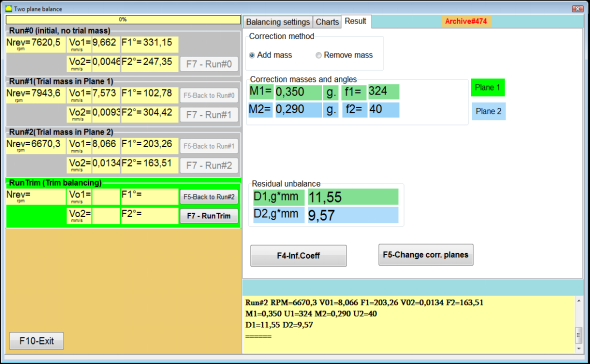
Fig. 7.36. Results of calculation of corrective weights – free position
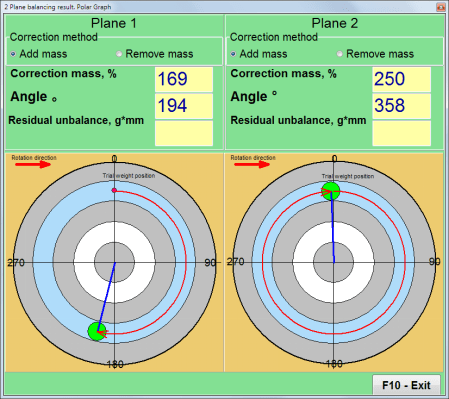
चित्र 7.37. सुधारात्मक भार की गणना के परिणाम – मुक्त स्थिति। ध्रुवीय आरेख
In the case of using the Weight Attachment Method" – "Fixed positions

चित्र 7.38. सुधारात्मक भार की गणना के परिणाम - निश्चित स्थिति।
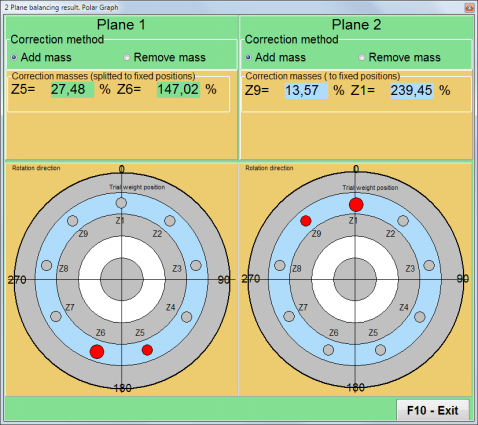
चित्र 7.39. सुधारात्मक भार की गणना के परिणाम – निश्चित स्थिति. ध्रुवीय आरेख.
वजन अटैचमेंट विधि का उपयोग करने के मामले में" – ""Circular groove"
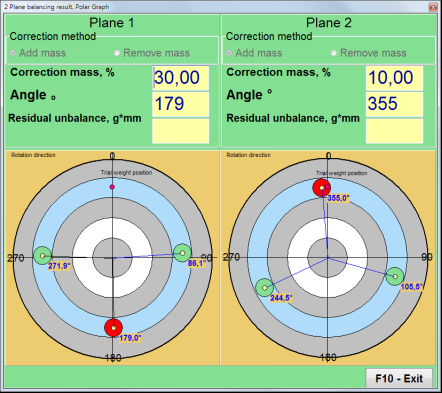
चित्र 7.40. सुधारात्मक भार की गणना के परिणाम - वृत्ताकार खांचा।
⚠️ ध्यान दें!
- माप प्रक्रिया पूरी करने के बाद RUN#2 of the balancing machine, stop the rotation of the rotor and remove the trial weight previously installed. Then you can to install (or remove) corrective weights.
- ध्रुवीय निर्देशांक प्रणाली में सुधारात्मक भार की कोणीय स्थिति की गणना रोटर के घूर्णन की दिशा में परीक्षण भार की स्थापना के स्थान से की जाती है।
- इस मामले में ""Fixed position""- 1st position (Z1), coincides with the place of installation of the trial weight. The counting direction of the position number is in the direction of rotation of the rotor.
- डिफ़ॉल्ट रूप से रोटर में सुधारात्मक भार जोड़ा जाएगा। यह " में सेट किए गए लेबल द्वारा इंगित किया गया है।"Add"" फ़ील्ड। यदि वज़न हटा रहे हैं (उदाहरण के लिए, ड्रिलिंग द्वारा), तो आपको " में एक निशान लगाना होगा।"Delete""क्षेत्र, जिसके बाद सुधार भार की कोणीय स्थिति स्वचालित रूप से 180º से बदल जाएगी।.
RunC (Trim run)
After installing the correction weight on the balancing rotor it is necessary to carry out a RunC (trim) and evaluate the effectiveness of the performed balancing.
⚠️ ध्यान दें! परीक्षण रन पर माप शुरू करने से पहले, मशीन के रोटर के रोटेशन को चालू करना और यह सुनिश्चित करना आवश्यक है कि यह ऑपरेटिंग गति में प्रवेश कर गया है।
रनट्रिम (संतुलन गुणवत्ता जांच) अनुभाग में कंपन मापदंडों को मापने के लिए, " पर क्लिक करें"F7 – RunTrim"" बटन दबाएं (या कंप्यूटर कीबोर्ड पर F7 कुंजी दबाएं)।.
The results of measuring the rotor rotation frequency (RPM), as well as the value of the RMS component (Vо1) and phase (F1) of 1x vibration will be shown.
""Result"कार्य विंडो के दाईं ओर "टैब" दिखाई देता है जिसमें माप परिणामों की तालिका होती है, जो अतिरिक्त सुधारात्मक भार के मापदंडों की गणना के परिणाम प्रदर्शित करती है।.
These weights can be added to corrective weights that are already installed on the rotor to compensate for residual imbalance.
In addition, the residual rotor unbalance achieved after balancing is displayed in the lower part of this window.
उस स्थिति में जब संतुलित रोटर के अवशिष्ट कंपन और / या अवशिष्ट असंतुलन के मान तकनीकी दस्तावेज में स्थापित सहिष्णुता आवश्यकताओं को पूरा करते हैं, तो संतुलन प्रक्रिया पूरी की जा सकती है।
Otherwise, the balancing process may continue. This allows the method of successive approximations to correct possible errors that may occur during the installation (removal) of the corrective weight on a balanced rotor.
बैलेंसिंग रोटर पर बैलेंसिंग प्रक्रिया जारी रखते समय, अतिरिक्त करेक्टिव मास को स्थापित (हटाना) आवश्यक है, जिसके पैरामीटर "परिणाम" विंडो में दर्शाए गए हैं।.
"में"Result""खिड़की में दो नियंत्रण बटन हैं जिनका उपयोग किया जा सकता है।""F4-Inf.Coeff", "F5 – Change correction planes".
Influence coefficients (2 planes)
""F4-Inf.Coeff""बटन (या कंप्यूटर कीबोर्ड पर F4 फ़ंक्शन कुंजी) का उपयोग दो अंशांकन प्रारंभ के परिणामों से गणना किए गए रोटर संतुलन गुणांक को देखने और कंप्यूटर मेमोरी में सहेजने के लिए किया जाता है।.
जब इसे दबाया जाता है, तो ""Influence coefficients (two planes)"कंप्यूटर डिस्प्ले पर एक वर्किंग विंडो दिखाई देती है, जिसमें पहले तीन कैलिब्रेशन आरंभ के परिणामों के आधार पर गणना किए गए संतुलन गुणांक प्रदर्शित होते हैं।.

Fig. 7.41. Working window with balancing coefficients in 2 planes.
भविष्य में, इस प्रकार की मशीन का संतुलन करते समय, " का उपयोग करना आवश्यक होगा।"Saved coeff.""मोड और संतुलन गुणांक कंप्यूटर मेमोरी में संग्रहीत होते हैं।".
गुणांकों को सहेजने के लिए, " पर क्लिक करें"F9 – Save"" बटन दबाएं और " पर जाएं"Influence coefficients archive (2planes)"खिड़कियाँ (चित्र 7.42 देखें)
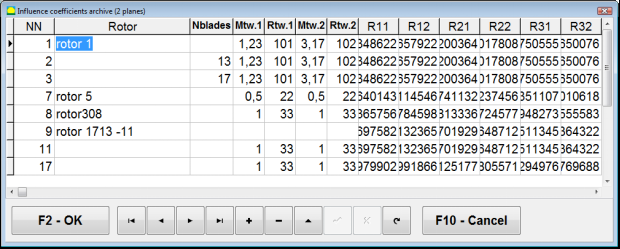
Fig. 7.42. The second page of the working window with balancing coefficients in 2 planes.
Change correction planes
""F5 – Change correction planes"" बटन का उपयोग तब किया जाता है जब सुधार तलों की स्थिति को बदलने की आवश्यकता होती है, जब द्रव्यमान और स्थापना कोणों के सुधारात्मक भार की पुनर्गणना करना आवश्यक होता है।.
This mode is primarily useful when balancing rotors of complex shape (for example, crankshafts).
जब इस बटन को दबाया जाता है, तो कार्यशील विंडो ""Recalculation of correction weights mass and angle to other correction planes"कंप्यूटर डिस्प्ले पर " प्रदर्शित होता है।.
In this working window, you should select one of the 4 possible options by clicking corresponding picture.
मूल सुधार समतल (Н1 और Н2) हरे रंग में चिह्नित हैं, और नए (K1 और K2), जिनके लिए यह पुनर्गणना करता है, लाल रंग में चिह्नित हैं।
फिर, ""Calculation data""अनुभाग" में, अनुरोधित डेटा दर्ज करें, जिसमें निम्नलिखित शामिल हैं:
- संगत सुधार विमानों (ए, बी, सी) के बीच की दूरी;
- रोटर पर सुधारात्मक भारों की स्थापना की त्रिज्याओं के नए मान (R1', R2')।.
डेटा दर्ज करने के बाद, आपको " बटन दबाना होगा"F9-calculate"
गणना परिणाम (द्रव्यमान M1, M2 और सुधारात्मक भार f1, f2 के स्थापना कोण) इस कार्यशील विंडो के संबंधित अनुभाग में प्रदर्शित किए जाते हैं।
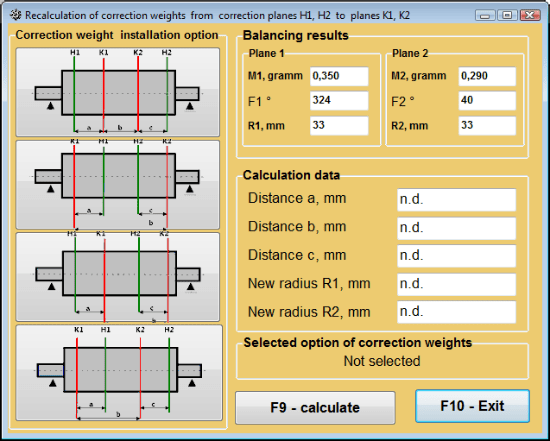
चित्र 7.43 सुधार तलों में परिवर्तन। अन्य सुधार तलों के लिए सुधार द्रव्यमान और कोण की पुनर्गणना।
2 तलों में संतुलन गुणांक बचाया गया
Saved coeff. balancing can be performed on a machine for which balancing coefficients have already been determined and saved in the computer memory.
⚠️ ध्यान दें! When re-balancing, the vibration sensors and the phase angle sensor must be installed in the same way as during the initial balancing.
पुनर्संतुलन के लिए प्रारंभिक डेटा का इनपुट " में शुरू होता है"दो समतल संतुलन. संतुलन सेटिंग्स".
इस मामले में, ""Influence coefficients"" अनुभाग में, " का चयन करें"Saved coeff."आइटम। इस मामले में, खिड़की।"Influence coefficients archive (2planes)""दिखाई देगा, जिसमें पहले से निर्धारित संतुलन गुणांकों का संग्रह संग्रहीत है।.
इस संग्रह की तालिका में "►" या "◄" नियंत्रण बटनों का उपयोग करके आगे बढ़ते हुए, आप अपनी रुचि की मशीन के संतुलन गुणांकों के साथ वांछित रिकॉर्ड का चयन कर सकते हैं। फिर, वर्तमान मापों में इस डेटा का उपयोग करने के लिए, " बटन दबाएँ।"F2 – OK""बटन दबाएं और पिछली कार्यशील विंडो पर वापस जाएं।.
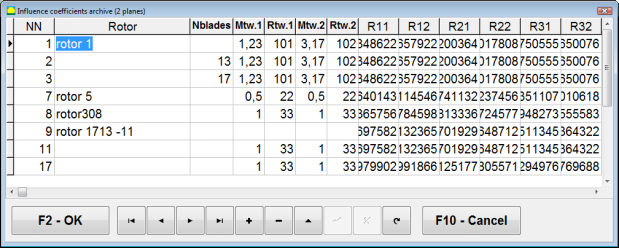
Fig. 7.44. The second page of the working window with balancing coefficients in 2 planes.
उसके बाद, " की अन्य सभी विंडो की सामग्री"2 pl में संतुलन। स्रोत डेटा"" यह स्वचालित रूप से भर जाता है।.
Saved coeff. Balancing
"Saved coeff.""संतुलन के लिए केवल एक ट्यूनिंग स्टार्ट और बैलेंसिंग मशीन का कम से कम एक टेस्ट स्टार्ट आवश्यक होता है।".
Vibration measurement at the tuning start (Run # 0मशीन का प्रदर्शन ""Balancing in 2 planes""संतुलन परिणामों की तालिका के साथ कार्यशील विंडो" Run # 0 section.
⚠️ ध्यान दें! Before starting the measurement, it is necessary to turn on the rotation of the rotor of the balancing machine and make sure that it has entered the operating mode with a stable speed.
To measure vibration parameters in the Run # 0 इस सेक्शन में, " पर क्लिक करें"F7 – Run#0"" बटन दबाएं (या कंप्यूटर कीबोर्ड पर F7 कुंजी दबाएं)।.
The results of measuring the rotor speed (RPM), as well as the value of the components of the RMS (VО1, VО2) and phases (F1, F2) of the 1x vibration appear in the corresponding fields of the Run # 0 section.
साथ ही, ""Result"" टैब खुलता है, जो रोटर के असंतुलन की भरपाई के लिए उस पर लगाए जाने वाले सुधारात्मक भार के मापदंडों की गणना के परिणाम प्रदर्शित करता है।.
इसके अलावा, ध्रुवीय निर्देशांक प्रणाली का उपयोग करने के मामले में, प्रदर्शन सुधारात्मक भार के द्रव्यमान मूल्यों और स्थापना कोणों को दर्शाता है।
In the case of decomposition of corrective weights on the blades, the numbers of the blades of the balancing rotor and the mass of weight that need to be installed on them are displayed.
Further, the balancing process is carried out in accordance with the recommendations set out in section 7.6.1.2. for primary balancing.
⚠️ ध्यान दें!
- After completion of the measurement process after the second start of the balanced machine stop the rotation of its rotor and remove the previously set trial weight. Only then you can begin to install (or remove) correction weight on the rotor.
- Counting the angular position of the place of adding (or removing) of the correction weight from the rotor is carried out on the installation site of trial weight in the polar coordinate system. Counting direction coincides with the direction of the angle of rotor rotation.
- ब्लेड पर संतुलन के मामले में - संतुलित रोटर ब्लेड, जिसे स्थिति 1 के रूप में निर्दिष्ट किया गया है, परीक्षण भार स्थापना के स्थान के साथ मेल खाता है। कंप्यूटर डिस्प्ले पर दिखाई गई ब्लेड की संदर्भ संख्या दिशा रोटर घूर्णन की दिशा में की जाती है।
- इस प्रोग्राम के इस संस्करण में, रोटर पर करेक्शन वेट को डिफ़ॉल्ट रूप से जोड़ा जाना तय है। "जोड़ना" फ़ील्ड में सेट किया गया टैग इसकी पुष्टि करता है। यदि किसी वेट को हटाकर (उदाहरण के लिए ड्रिलिंग द्वारा) असंतुलन को ठीक किया जाता है, तो "हटाना" फ़ील्ड में टैग सेट करना आवश्यक है, जिसके बाद करेक्शन वेट की कोणीय स्थिति स्वचालित रूप से 180º बदल जाएगी।.
मैंड्रेल की विलक्षणता का उन्मूलन (सूचकांक संतुलन) - दो तल
If during balancing the rotor is installed in a cylindrical mandrel, then the eccentricity of the mandrel may introduce an additional error. To eliminate this error, the rotor should be deployed in the mandrel 180 degrees and carry out an additional start. This is called index balancing.
To carry out index balancing, a special option is provided in the Balanset-1A program. When checked Mandrel eccentricity elimination an additional RunEcc section appears in the balancing window.
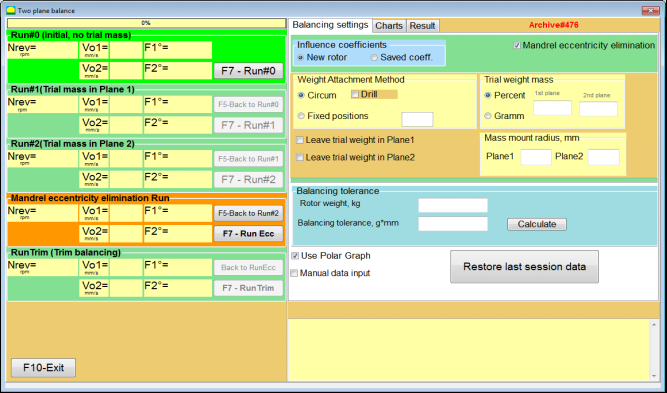
Fig. 7.45. The working window for Index balancing.
After running Run # 2 (Trial mass Plane 2), a window will appear
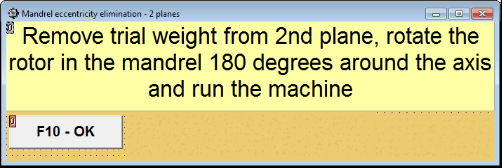
Fig. 7.46. Attention windows
रोटर को 180° घुमाकर स्थापित करने के बाद, रन Ecc पूरा करना होगा। प्रोग्राम स्वचालित रूप से मैंड्रेल की उत्केन्द्रता को प्रभावित किए बिना वास्तविक रोटर असंतुलन की गणना करेगा।
7.6 चार्ट मोड
"चार्ट" मोड में काम करना प्रारंभिक विंडो (चित्र 7.1 देखें) से शुरू होता है, ""F8 – चार्ट"। फिर एक विंडो खुलती है "दो चैनलों पर कंपन का मापन। चार्ट" (चित्र 7.19 देखें)।.

चित्र 7.47. ऑपरेटिंग विंडो "दो चैनलों पर कंपन का मापन। चार्ट"।.
While working in this mode it is possible to plot four versions of vibration chart.
The first version allows to get a timeline function of the overall vibration (of vibration velocity) on the first and second measuring channels.
The second version allows you to get graphs of vibration (of vibration velocity), which occurs on rotation frequency and its higher harmonical components.
These graphs are obtained as a result of the synchronous filtering of the overall vibration time function.
The third version provides vibration charts with the results of the harmonical analysis.
The fourth version allows to get a vibration chart with the results of the spectrum analysis.
समग्र कंपन के चार्ट
ऑपरेटिंग विंडो में समग्र कंपन चार्ट बनाने के लिए ""Measurement of vibration on two channels. Charts""ऑपरेटिंग मोड का चयन करना आवश्यक है।""overall vibration"उपयुक्त बटन पर क्लिक करके। फिर "▼" बटन पर क्लिक करके "सेकंड में अवधि" बॉक्स में कंपन का माप सेट करें और ड्रॉप-डाउन सूची से माप प्रक्रिया की वांछित अवधि का चयन करें, जो 1, 5, 10, 15 या 20 सेकंड के बराबर हो सकती है;
तैयार होने पर " बटन दबाएँ (क्लिक करें)"F9"मापें" बटन दबाने पर कंपन मापन प्रक्रिया एक साथ दो चैनलों पर शुरू हो जाती है।.
After completion of the measurement process in the operating window appear charts of time function of the overall vibration of the first (red) and the second (green) channels (see. Fig. 7.47).
On these charts time is plotted on X-axis and the amplitude of the vibration velocity (mm/sec) is plotted on Y-axis.
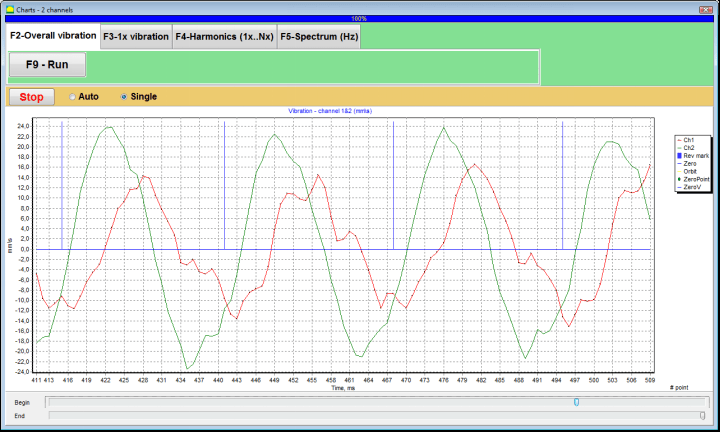
चित्र 7.48. समग्र कंपन चार्ट के समय फ़ंक्शन के आउटपुट के लिए ऑपरेटिंग विंडो
There are also marks (blue-colored) in these graphs connecting charts of overall vibration with the rotation frequency of the rotor. In addition, each mark indicates beginning (end) of the next revolution of the rotor.
In need of the scale change of the chart on X-axis the slider, pointed by an arrow on fig. 7.20, can be used.
1x कंपन के चार्ट
ऑपरेटिंग विंडो में 1x कंपन चार्ट बनाने के लिए ""Measurement of vibration on two channels. Charts""ऑपरेटिंग मोड का चयन करना आवश्यक है।""1x vibration"उपयुक्त बटन पर क्लिक करके।.
फिर "1x वाइब्रेशन" ऑपरेटिंग विंडो दिखाई देती है।.
" दबाएँ (क्लिक करें)"F9"मापें" बटन दबाने पर कंपन मापन प्रक्रिया एक साथ दो चैनलों पर शुरू हो जाती है।.
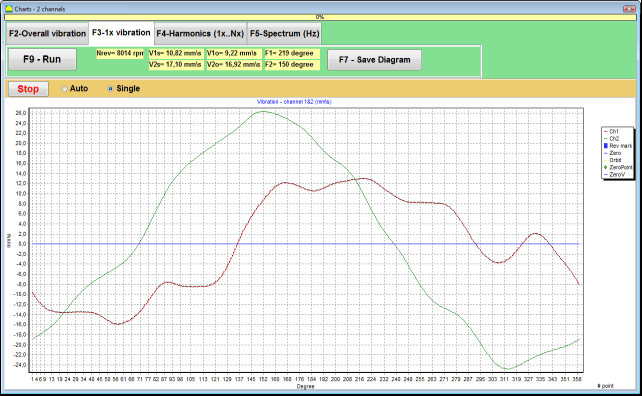
चित्र 7.49. 1x कंपन चार्ट के आउटपुट के लिए ऑपरेटिंग विंडो.
After completion of the measurement process and mathematical calculation of results (synchronous filtering of the time function of the overall vibration) on display in the main window on a period equal to one revolution of the rotor appear charts of the 1x vibration on two channels.
In this case, a chart for the first channel is depicted in red and for the second channel in green. On these charts angle of the rotor revolution is plotted (from mark to mark) on X-axis and the amplitude of the vibration velocity (mm/sec) is plotted on Y-axis.
इसके अलावा, वर्किंग विंडो के ऊपरी भाग में (बटन " के दाईं ओर)"F9 – माप"") दोनों चैनलों के कंपन मापों के संख्यात्मक मान, जो हमें " में प्राप्त होते हैं"Vibration meter""मोड, प्रदर्शित होते हैं।.
In particular: RMS value of the overall vibration (V1s, V2s), the magnitude of RMS (V1o, V2o) and phase (Fi, Fj) of the 1x vibration and rotor speed (Nrev).
हार्मोनिक विश्लेषण के परिणामों के साथ कंपन चार्ट
ऑपरेटिंग विंडो में हार्मोनिकल विश्लेषण के परिणामों के साथ एक चार्ट बनाने के लिए ""Measurement of vibration on two channels. Charts""ऑपरेटिंग मोड का चयन करना आवश्यक है।""Harmonical analysis"उपयुक्त बटन पर क्लिक करके।.
फिर अस्थायी कार्य के चार्ट और कंपन हार्मोनिक पहलुओं के स्पेक्ट्रम के एक साथ आउटपुट के लिए एक ऑपरेटिंग विंडो दिखाई देती है, जिसकी अवधि रोटर रोटेशन आवृत्ति के बराबर या गुणक होती है।
Attention!
When operating in this mode it is necessary to use the phase angle sensor which synchronizes the measurement process with the rotor frequency of the machines to which the sensor is set.
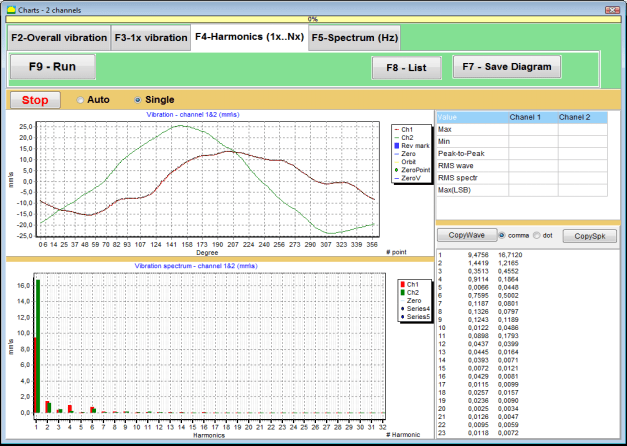
चित्र 7.50. 1x कंपन के ऑपरेटिंग विंडो हार्मोनिक्स.
तैयार होने पर " बटन दबाएँ (क्लिक करें)"F9"मापें" बटन दबाने पर कंपन मापन प्रक्रिया एक साथ दो चैनलों पर शुरू हो जाती है।.
मापन प्रक्रिया पूरी होने के बाद ऑपरेटिंग विंडो में समय फ़ंक्शन (उच्च चार्ट) और 1x कंपन (निचला चार्ट) के हार्मोनिक्स के चार्ट दिखाई देते हैं।
The number of harmonic components is plotted on X-axis and RMS of the vibration velocity (mm/sec) is plotted on Y-axis.
कंपन समय डोमेन और स्पेक्ट्रम के चार्ट
स्पेक्ट्रम चार्ट बनाने के लिए " का उपयोग करें"F5-स्पेक्ट्रम"" टैब:
इसके बाद तरंग और कंपन स्पेक्ट्रम के चार्ट के एक साथ आउटपुट के लिए एक ऑपरेटिंग विंडो दिखाई देती है।

चित्र 7.51. कंपन स्पेक्ट्रम के आउटपुट के लिए ऑपरेटिंग विंडो.
तैयार होने पर " बटन दबाएँ (क्लिक करें)"F9"मापें" बटन दबाने पर कंपन मापन प्रक्रिया एक साथ दो चैनलों पर शुरू हो जाती है।.
मापन प्रक्रिया पूरी होने के बाद ऑपरेटिंग विंडो में समय फ़ंक्शन (उच्च चार्ट) और कंपन स्पेक्ट्रम (निचला चार्ट) के चार्ट दिखाई देते हैं।
The vibration frequency is plotted on X-axis and RMS of the vibration velocity (mm/sec) is plotted on Y-axis.
In this case, a chart for the first channel is depicted in red and for the second channel in green.
8. उपकरण के संचालन और रखरखाव पर सामान्य निर्देश
8.1 गुणवत्ता मानदंड को संतुलित करना (आईएसओ 2372 मानक)
संतुलन की गुणवत्ता का मूल्यांकन ISO 2372 मानक द्वारा निर्धारित कंपन स्तरों का उपयोग करके किया जा सकता है। नीचे दी गई तालिका विभिन्न मशीन वर्गों के लिए स्वीकार्य कंपन स्तरों को दर्शाती है:
| मशीन वर्ग | Good (मिमी/सेकंड आरएमएस) |
स्वीकार्य (मिमी/सेकंड आरएमएस) |
अभी भी स्वीकार्य (मिमी/सेकंड आरएमएस) |
गवारा नहीं (मिमी/सेकंड आरएमएस) |
|---|---|---|---|---|
| वर्ग 1 कठोर नींव पर छोटी मशीनें (15 किलोवाट तक की मोटरें) |
< 0.7 | 0.7 - 1.8 | 1.8 - 4.5 | > 4.5 |
| कक्षा 2 बिना नींव वाली मध्यम मशीनें (मोटर्स 15-75 किलोवाट), ड्राइव मैकेनिज्म 300 किलोवाट तक |
< 1.1 | 1.1 - 2.8 | 2.8 - 7.1 | > 7.1 |
| कक्षा 3 कठोर नींव पर बड़ी मशीनें (300 किलोवाट से अधिक उपकरण) |
< 1.8 | 1.8 - 4.5 | 4.5 - 11 | > 11 |
| कक्षा 4 हल्के नींव पर बड़ी मशीनें (300 किलोवाट से अधिक उपकरण) |
< 2.8 | 2.8 - 7.1 | 7.1 - 18 | > 18 |
नोट: ये मान संतुलन गुणवत्ता के मूल्यांकन के लिए मार्गदर्शन प्रदान करते हैं। हमेशा अपने अनुप्रयोग के लिए विशिष्ट उपकरण निर्माता विनिर्देशों और लागू मानकों का संदर्भ लें।
8.2 रखरखाव आवश्यकताएँ
🔧 नियमित रखरखाव
- ✓निर्माता विनिर्देशों के अनुसार सेंसरों का नियमित अंशांकन
- ✓सेंसरों को साफ़ रखें और चुंबकीय मलबे से मुक्त रखें
- ✓उपयोग में न होने पर उपकरण को सुरक्षात्मक केस में रखें
- ✓लेजर सेंसर को धूल और नमी से बचाएं
- ✓केबल कनेक्शनों की नियमित रूप से जांच करें कि कहीं वे घिसे या क्षतिग्रस्त तो नहीं हैं
- ✓निर्माता द्वारा अनुशंसित सॉफ़्टवेयर अपडेट करें
- ✓महत्वपूर्ण संतुलन डेटा की बैकअप प्रतियां बनाए रखें
📋 यूरोपीय संघ के रखरखाव मानक
उपकरण रखरखाव का अनुपालन निम्नलिखित होना चाहिए:
- EN ISO 9001: गुणवत्ता प्रबंधन प्रणाली आवश्यकताएँ
- एन 13306: रखरखाव शब्दावली और परिभाषाएँ
- एन 15341: रखरखाव प्रमुख प्रदर्शन संकेतक
- यूरोपीय संघ के मशीनरी निर्देशों के अनुसार नियमित सुरक्षा निरीक्षण
अनुलग्नक 1. रोटर संतुलन
रोटर एक ऐसा पिंड है जो एक निश्चित अक्ष के चारों ओर घूमता है और इसके बेयरिंग सतहों द्वारा सपोर्ट में टिका रहता है। रोटर की बेयरिंग सतहें रोलिंग या स्लाइडिंग बेयरिंग के माध्यम से भार को सपोर्ट तक पहुंचाती हैं। "बेयरिंग सतह" शब्द का प्रयोग करते समय हमारा तात्पर्य केवल जर्नल* या जर्नल-प्रतिस्थापित सतहों से होता है।.
*जर्नल (जर्मन में "जर्नल" या "पिन" के लिए ज़ैप्फेन) - शाफ्ट या अक्ष का एक हिस्सा है, जिसे होल्डर (बेयरिंग बॉक्स) द्वारा ले जाया जाता है।.
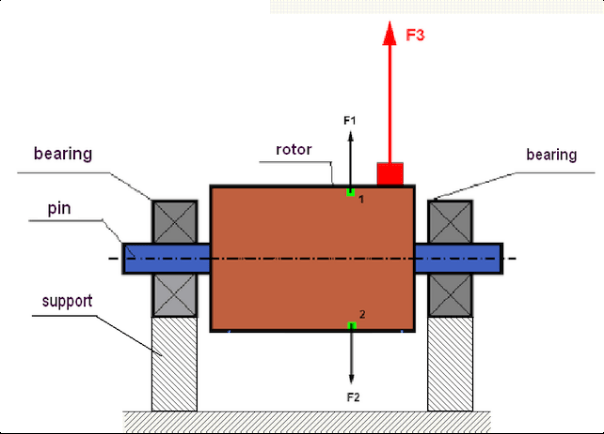
fig.1 Rotor and centrifugal forces.
In a perfectly balanced rotor, its mass is distributed symmetrically regarding the axis of the rotation. This means that any element of the rotor can correspond to another element located symmetrically in a relation to the axis of the rotation. During rotation, each rotor element acts upon by a centrifugal force directed in the radial direction (perpendicular to the axis of the rotor rotation). In a balanced rotor, the centrifugal force influencing any element of the rotor is balanced by the centrifugal force that influences the symmetrical element. For example, elements 1 and 2 (shown in fig.1 and colored in green) are influenced by centrifugal forces F1 and F2: equal in value and absolutely opposite in directions. This is true for all symmetrical elements of the rotor and thus the total centrifugal force influencing the rotor is equal to 0 the rotor is balanced. But if the symmetry of the rotor is broken (in Figure 1, the asymmetric element is marked in red), then the unbalanced centrifugal force F3 begins to act on the rotor.
घूर्णन करते समय, यह बल रोटर के घूर्णन के साथ-साथ दिशा भी बदलता है। इस बल से उत्पन्न गतिशील भार बियरिंग्स पर स्थानांतरित हो जाता है, जिससे उनका घिसाव तेज़ हो जाता है। इसके अतिरिक्त, इस परिवर्तनशील बल के प्रभाव में, आधारों और उस आधार का, जिस पर रोटर स्थिर है, चक्रीय विरूपण होता है, जिससे कंपन उत्पन्न होता है। रोटर के असंतुलन और उससे जुड़े कंपन को दूर करने के लिए, संतुलन द्रव्यमान स्थापित करना आवश्यक है, जो रोटर की समरूपता को बहाल करेगा।
Rotor balancing is an operation to eliminate imbalance by adding balancing masses.
The task of balancing is to find the value and places (angle) of the installation of one or more balancing masses.
रोटर्स के प्रकार और असंतुलन
Considering the strength of the rotor material and the magnitude of the centrifugal forces influencing it, the rotors can be divided into two types: rigid and flexible.
केन्द्रापसारक बल के प्रभाव में परिचालन स्थितियों में कठोर रोटर थोड़ा विकृत हो सकते हैं, लेकिन गणना में इस विरूपण के प्रभाव को नजरअंदाज किया जा सकता है।
Deformation of flexible rotors on the other hand should never be neglected. The deformation of flexible rotors complicates the solution for the balancing problem and requires the use of some other mathematical models in comparison with the task of balancing rigid rotors. It is important to mention that the same rotor at low speeds of rotation can behave like rigid one and at high speeds it will behave like flexible one. Further on we will consider the balancing of rigid rotors only.
रोटर की लंबाई के साथ असंतुलित द्रव्यमानों के वितरण के आधार पर, दो प्रकार के असंतुलनों को पहचाना जा सकता है - स्थैतिक और गतिशील। यही बात स्थैतिक और गतिशील रोटर संतुलन पर भी लागू होती है।
रोटर के घूर्णन के बिना ही उसका स्थैतिक असंतुलन उत्पन्न होता है। दूसरे शब्दों में, जब रोटर गुरुत्वाकर्षण के प्रभाव में होता है और साथ ही "भारी बिंदु" को नीचे की ओर घुमाता है, तब यह स्थिर अवस्था में होता है। स्थैतिक असंतुलन वाले रोटर का एक उदाहरण चित्र 2 में दर्शाया गया है।

Fig.2
The dynamic imbalance occurs only when the rotor spins.
An example of a rotor with the dynamic imbalance is presented in Fig.3.
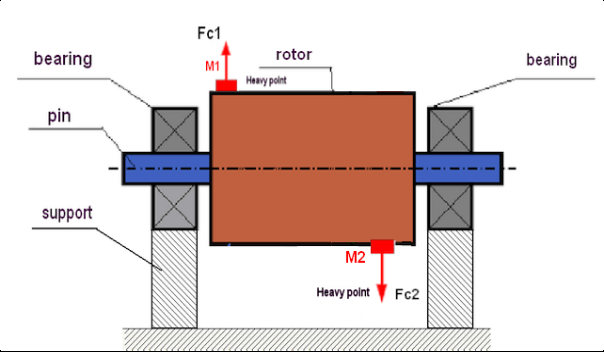
Fig.3. Dynamic imbalance of rotor – couple of the centrifugal forces
इस स्थिति में, असंतुलित समान द्रव्यमान M1 और M2 रोटर की लंबाई के अनुदिश विभिन्न सतहों पर स्थित हैं। स्थिर अवस्था में, यानी जब रोटर घूमता नहीं है, तो रोटर केवल गुरुत्वाकर्षण बल से प्रभावित होता है और इसलिए द्रव्यमान एक दूसरे को संतुलित करते हैं। गतिकी में, जब रोटर घूमने लगता है, तो द्रव्यमान M1 और M2 अपकेंद्रीय बल FЎ1 और FЎ2 से प्रभावित होने लगते हैं। ये बल मान में बराबर और दिशा में विपरीत होते हैं। हालांकि, चूंकि वे शाफ्ट की लंबाई के अनुदिश अलग-अलग स्थानों पर स्थित हैं और एक ही रेखा में नहीं हैं, इसलिए बल एक दूसरे को संतुलित नहीं करते हैं। FЎ1 और FЎ2 के बल रोटर पर एक क्षणिक बल उत्पन्न करते हैं। यही कारण है कि इस असंतुलन को "क्षणिक" भी कहा जाता है। इसके परिणामस्वरूप, असंतुलित अपकेंद्रीय बल बेयरिंग सपोर्ट पर कार्य करते हैं, जो हमारे द्वारा अनुमानित बलों से काफी अधिक हो सकते हैं और बेयरिंग के सेवा जीवन को भी कम कर सकते हैं।.
क्योंकि इस प्रकार का असंतुलन केवल रोटर के घूमने के दौरान गति में ही उत्पन्न होता है, इसलिए इसे गतिशील असंतुलन कहा जाता है। इसे स्थैतिक संतुलन (या तथाकथित "चाकू पर") या किसी अन्य समान विधि से दूर नहीं किया जा सकता है। गतिशील असंतुलन को दूर करने के लिए, दो प्रतिपूरक भार स्थापित करना आवश्यक है जो M1 और M2 द्रव्यमानों से उत्पन्न होने वाले आघूर्ण के बराबर मान और विपरीत दिशा में आघूर्ण उत्पन्न करें। प्रतिपूरक भारों को M1 और M2 द्रव्यमानों के ठीक विपरीत स्थापित करना और उनके बराबर मान का होना आवश्यक नहीं है। सबसे महत्वपूर्ण बात यह है कि वे असंतुलन के ठीक क्षण में एक ऐसा आघूर्ण उत्पन्न करें जो पूरी तरह से क्षतिपूर्ति करे।.
सामान्यतः, द्रव्यमान M1 और M2 एक दूसरे के बराबर नहीं होते, इसलिए स्थैतिक और गतिशील असंतुलन का संयोजन होगा। सैद्धांतिक रूप से यह सिद्ध हो चुका है कि एक कठोर रोटर के असंतुलन को दूर करने के लिए, रोटर की लंबाई के अनुदिश दो भार लगाना आवश्यक और पर्याप्त है। ये भार गतिशील असंतुलन से उत्पन्न क्षण और रोटर अक्ष के सापेक्ष द्रव्यमान की विषमता (स्थैतिक असंतुलन) से उत्पन्न अपकेंद्रीय बल दोनों को संतुलित करेंगे। सामान्यतः, गतिशील असंतुलन लंबे रोटरों, जैसे शाफ्ट, के लिए विशिष्ट होता है, और स्थैतिक असंतुलन संकरे रोटरों के लिए। हालांकि, यदि संकरा रोटर अक्ष के सापेक्ष तिरछा लगाया गया हो, या इससे भी बदतर, विकृत (तथाकथित "पहिया डगमगाहट") हो, तो इस स्थिति में गतिशील असंतुलन को दूर करना कठिन होगा (चित्र 4 देखें), क्योंकि सही संतुलनकारी क्षण उत्पन्न करने वाले भारों को लगाना मुश्किल होता है।.
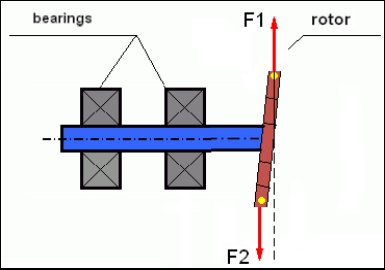
Fig.4 Dynamic balancing of the wobbling wheel
चूंकि रोटर का संकरा किनारा एक छोटा मोमेंट उत्पन्न करता है, इसलिए इसमें अधिक द्रव्यमान वाले भारों को समायोजित करने की आवश्यकता हो सकती है। लेकिन साथ ही, समायोजित करने वाले भारों से उत्पन्न अपकेंद्रीय बलों के प्रभाव से संकरे रोटर के विरूपण के कारण एक अतिरिक्त तथाकथित "प्रेरित असंतुलन" भी उत्पन्न होता है।.
See the example:
""रिजिड रोटर्स के संतुलन पर व्यवस्थित निर्देश"" ISO 1940-1:2003 Mechanical vibration – Balance quality requirements for rotors in a constant (rigid) state – Part 1: Specification and verification of balance tolerances
This is visible for narrow fan wheels, which, in addition to the power imbalance, also influences an aerodynamic imbalance. And it is important to bear in mind that the aerodynamic imbalance, in fact the aerodynamic force, is directly proportional to the angular velocity of the rotor, and to compensate it, the centrifugal force of the correcting mass is used, which is proportional to the square of the angular velocity. Therefore, the balancing effect may only occur at a specific balancing frequency. At other speeds there would be an additional gap. The same can be said about electromagnetic forces in an electromagnetic motor, which are also proportional to the angular velocity. In other words it is impossible to eliminate all causes of vibration of the mechanism by any means of balancing.
कंपन के मूल सिद्धांत
कंपन चक्रीय उत्तेजना बल के प्रभाव के प्रति तंत्र डिज़ाइन की प्रतिक्रिया है। इस बल की प्रकृति भिन्न हो सकती है।
- रोटर के असंतुलन के कारण उत्पन्न अपकेंद्रीय बल एक असंतुलित बल है जो "भारी बिंदु" को प्रभावित करता है। विशेष रूप से यह बल और इसके कारण होने वाला कंपन रोटर संतुलन द्वारा समाप्त कर दिया जाता है।.
- परस्पर क्रिया करने वाले बल, जिनका स्वरूप "ज्यामितीय" होता है और जो आपस में जुड़ने वाले पुर्जों के निर्माण और स्थापना में त्रुटियों के कारण उत्पन्न होते हैं। ये बल, उदाहरण के लिए, शाफ्ट जर्नल की गोलाई न होने, गियर में दांतों के प्रोफाइल में त्रुटियों, बेयरिंग रेसवे की लहरदारता, आपस में जुड़ने वाले शाफ्टों के गलत संरेखण आदि के कारण हो सकते हैं। गर्दन की गोलाई न होने की स्थिति में, शाफ्ट की धुरी शाफ्ट के घूर्णन कोण के आधार पर स्थानांतरित हो जाएगी। यद्यपि यह कंपन रोटर की गति पर प्रकट होता है, लेकिन संतुलन द्वारा इसे समाप्त करना लगभग असंभव है।.
- Aerodynamic forces arising from the rotation of the impeller fans and other blade mechanisms. Hydrodynamic forces arising from the rotation of hydraulic pump impellers, turbines, etc.
- विद्युत मशीनों के संचालन के परिणामस्वरूप उत्पन्न होने वाले विद्युत चुम्बकीय बल, उदाहरण के लिए, रोटर वाइंडिंग की विषमता, शॉर्ट-सर्किटेड घुमावों की उपस्थिति आदि के कारण।
The magnitude of vibration (for example, its amplitude AB) depends not only on the magnitude of the excitation force Fт acting on the mechanism with the circular frequency ω, but also on the stiffness k of the structure of the mechanism, its mass m, and damping coefficient C.

Various types of sensors can be used to measure vibration and balance mechanisms, including:
- absolute vibration sensors designed to measure vibration acceleration (accelerometers) and vibration velocity sensors;
- सापेक्ष कंपन सेंसर भंवर-वर्तमान या कैपेसिटिव, कंपन को मापने के लिए डिज़ाइन किए गए हैं।
In some cases (when the structure of the mechanism allows it) sensors of force can also be used to examine its vibration weight.
Particularly, they are widely used to measure the vibration weight of the supports of hardbearing balancing machines.
Therefore vibration is the reaction of the mechanism to the influence of external forces. The amount of vibration depends not only on the magnitude of the force acting on the mechanism, but also on the rigidity of the mechanism. Two forces with the same magnitude can lead to different vibrations. In mechanisms with a rigid support structure, even with the small vibration, the bearing units can be significantly influenced by dynamic weights. Therefore, when balancing mechanisms with stiff legs apply the force sensors, and vibration (vibro accelerometers). Vibration sensors are only used on mechanisms with relatively pliable supports, right when the action of unbalanced centrifugal forces leads to a noticeable deformation of the supports and vibration. Force sensors are used in rigid supports even when significant forces arising from imbalance do not lead to significant vibration.
संरचना की प्रतिध्वनि
We have previously mentioned that rotors are divided into rigid and flexible. The rigidity or flexibility of the rotor should not be confused with the stiffness or mobility of the supports (foundation) on which the rotor is located. The rotor is considered rigid when its deformation (bending) under the action of centrifugal forces can be neglected. The deformation of the flexible rotor is relatively large: it cannot be neglected.
इस लेख में हम केवल दृढ़ रोटरों के संतुलन का अध्ययन करेंगे। दृढ़ (अविकृत) रोटर, बदले में, दृढ़ या गतिशील (नमनीय) आधारों पर स्थित हो सकता है। यह स्पष्ट है कि आधारों की यह कठोरता/गतिशीलता रोटर की घूर्णन गति और परिणामी अपकेन्द्रीय बलों के परिमाण पर निर्भर करती है। पारंपरिक सीमा रोटर आधारों/आधार के मुक्त दोलनों की आवृत्ति है। यांत्रिक प्रणालियों के लिए, मुक्त दोलनों का आकार और आवृत्ति यांत्रिक प्रणाली के तत्वों के द्रव्यमान और प्रत्यास्थता द्वारा निर्धारित होती है। अर्थात्, प्राकृतिक दोलनों की आवृत्ति यांत्रिक प्रणाली की एक आंतरिक विशेषता है और बाह्य बलों पर निर्भर नहीं करती है। संतुलन अवस्था से विक्षेपित होने पर, आधार प्रत्यास्थता के कारण अपनी संतुलन स्थिति में वापस आ जाते हैं। लेकिन विशाल रोटर के जड़त्व के कारण, यह प्रक्रिया अवमंदित दोलनों की प्रकृति की होती है। ये दोलन रोटर-आधार प्रणाली के अपने दोलन होते हैं। उनकी आवृत्ति रोटर द्रव्यमान और समर्थन की लोच के अनुपात पर निर्भर करती है।
When the rotor begins to rotate and the frequency of its rotation approaches the frequency of its own oscillations, the vibration amplitude increases sharply, which can even lead to the destruction of the structure.
There is a phenomenon of mechanical resonance. In the resonance region, a change in the speed of rotation by 100 rpm can lead to an increase in a vibration tenfold. In this case (in the resonance region) the vibration phase changes by 180°.
यदि किसी यंत्र का डिज़ाइन दोषपूर्ण है और रोटर की परिचालन गति दोलनों की प्राकृतिक आवृत्ति के निकट है, तो असहनीय रूप से उच्च कंपन के कारण यंत्र का संचालन असंभव हो जाता है। मानक संतुलन विधियाँ भी अव्यवहार्य हो जाती हैं, क्योंकि घूर्णन गति में मामूली परिवर्तन से भी मापदंडों में भारी बदलाव आ जाता है। अनुनाद संतुलन के क्षेत्र में विशेष विधियों का उपयोग किया जाता है, लेकिन इस लेख में उनका विस्तृत वर्णन नहीं किया गया है। रोटर के बंद होने पर (रन-आउट के दौरान) या झटके के प्रभाव से यंत्र के प्राकृतिक दोलनों की आवृत्ति का निर्धारण किया जा सकता है, जिसके बाद झटके के प्रति तंत्र की प्रतिक्रिया का स्पेक्ट्रल विश्लेषण किया जाता है। "बैलेंसेट-1" इन विधियों द्वारा यांत्रिक संरचनाओं की प्राकृतिक आवृत्तियों का निर्धारण करने की क्षमता प्रदान करता है।.
For mechanisms whose operating speed is higher than the resonance frequency, that is, operating in the resonant mode, supports are considered as mobile ones and vibration sensors are used to measure, mainly vibration accelerometers that measure the acceleration of structural elements. For mechanisms operating in hard bearing mode, supports are considered as rigid. In this case, force sensors are used.
यांत्रिक प्रणाली के रैखिक और अरैखिक मॉडल
Mathematical models (linear) are used for calculations when balancing rigid rotors. The linearity of the model means that one model is directly proportionally (linearly) dependent on the other. For example, if the uncompensated mass on the rotor is doubled, then the vibration value will be doubled correspondingly. For rigid rotors you can use a linear model because such rotors are not deformed. It is no longer possible to use a linear model for flexible rotors. For a flexible rotor, with an increase of the mass of a heavy point during rotation, an additional deformation will occur, and in addition to the mass, the radius of the heavy point will also increase. Therefore, for a flexible rotor, the vibration will more than double, and the usual calculation methods will not work. Also, a violation of the linearity of the model can lead to a change in the elasticity of the supports at their large deformations, for example, when small deformations of the supports work some structural elements, and when large in the work include other structural elements. Therefore it is impossible to balance the mechanisms that are not fixed at the base, and, for example, are simply established on a floor. With significant vibrations, the unbalance force can detach the mechanism from the floor, thereby significantly changing the stiffness characteristics of the system. The engine legs must be securely fastened, bolted fasteners tightened, the thickness of the washers must provide sufficient rigidity, etc. With broken bearings, a significant displacement of the shaft and its impacts is possible, which will also lead to a violation of linearity and the impossibility of carrying out high-quality balancing.
Methods and devices for balancing
As mentioned above, balancing is the process of combining the main Central axis of inertia with the axis of rotation of the rotor.
The specified process can be executed in two ways.
The first method involves the processing of the rotor axles, which is performed in such a way that the axis passing through the centers of the section of the axles with the main Central axis of inertia of the rotor. This technique is rarely used in practice and will not be discussed in detail in this article.
The second (most common) method involves moving, installing or removing corrective masses on the rotor, which are placed in such a way that the axis of inertia of the rotor is as close as possible to the axis of its rotation.
Moving, adding or removing corrective masses during balancing can be done using a variety of technological operations, including: drilling, milling, surfacing, welding, screwing or unscrewing screws, burning with a laser beam or electron beam, electrolysis, electromagnetic welding, etc.
The balancing process can be performed in two ways:
- संतुलित रोटर्स असेंबली (अपने स्वयं के बीयरिंग में);
- संतुलन मशीनों पर रोटर्स का संतुलन।
To balance the rotors in their own bearings we usually use specialized balancing devices (kits), which allows us to measure the vibration of the balanced rotor at the speed of its rotation in a vector form, i.e. to measure both the amplitude and phase of vibration.
Currently, these devices are manufactured on the basis of microprocessor technology and (in addition to the measurement and analysis of vibration) provide automated calculation of the parameters of corrective weights that must be installed on the rotor to compensate its imbalance.
These devices include:
- कंप्यूटर या औद्योगिक नियंत्रक के आधार पर बनाई गई माप और कंप्यूटिंग इकाई;
- दो (या अधिक) कंपन सेंसर;
- चरण कोण सेंसर;
- सुविधा पर सेंसर की स्थापना के लिए उपकरण;
- एक, दो या अधिक सुधार विमानों में रोटर असंतुलन मापदंडों के माप का एक पूर्ण चक्र निष्पादित करने के लिए डिज़ाइन किया गया विशेष सॉफ्टवेयर।
बैलेंसिंग मशीनों पर रोटरों को संतुलित करने के लिए, एक विशेष बैलेंसिंग उपकरण (मशीन की मापन प्रणाली) के अलावा, एक "अनवाइंडिंग मैकेनिज्म" की आवश्यकता होती है, जिसे रोटर को सपोर्ट पर स्थापित करने और एक निश्चित गति पर इसके घूर्णन को सुनिश्चित करने के लिए डिज़ाइन किया गया हो।.
Currently, the most common balancing machines exist in two types:
- अति-अनुनाद (कोमल समर्थन के साथ);
- कठोर असर (कठोर समर्थन के साथ)।
Over-resonant machines have a relatively pliable supports, made, for example, on the basis of the flat springs.
The natural oscillation frequency of these supports is usually 2-3 times lower than the speed of the balanced rotor, which is mounted on them.
Vibration sensors (accelerometers, vibration velocity sensors, etc.) are usually used to measure the vibration of the supports of a resonant machine.
In the hardbearing balancing machines are used relatively-rigid supports, natural oscillation frequencies of which should be 2-3 times higher than the speed of the balanced rotor.
Force sensors are usually used to measure the vibration weight on the supports of the machine.
The advantage of the hard bearing balancing machines is that they can be balanced at relatively low rotor speeds (up to 400-500 rpm), which greatly simplifies the design of the machine and its foundation, as well as increases the productivity and safety of balancing.
Balancing technique
⚠️ संतुलन प्रक्रिया केवल घूर्णन अक्ष के सापेक्ष रोटर द्रव्यमान वितरण की विषमता के कारण उत्पन्न कंपन को ही समाप्त करती है। संतुलन प्रक्रिया से अन्य प्रकार के कंपन समाप्त नहीं किए जा सकते!
Balancing is the subject to technically serviceable mechanisms, the design of which ensures the absence of resonances at the operating speed, securely fixed on the foundation, installed in serviceable bearings.
🚫 दोषपूर्ण तंत्र की मरम्मत की जानी चाहिए, और उसके बाद ही उसका संतुलन किया जाना चाहिए। अन्यथा, गुणात्मक संतुलन असंभव है।.
Balancing cannot be a substitute for repair!
The main task of balancing is to find the mass and the place (angle) of installation of compensating weights, which are balanced by centrifugal forces.
As mentioned above, for rigid rotors it is generally necessary and sufficient to install two compensating weights. This will eliminate both the static and dynamic rotor imbalance. A general scheme of the vibration measurement during balancing looks like the following:
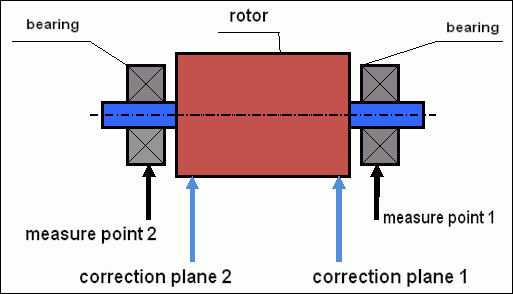
fig.5 Dynamic balancing – correction planes and measure points
Vibration sensors are installed on the bearing supports at points 1 and 2. The speed mark is fixed right on the rotor, a reflective tape is glued usually. The speed mark is used by the laser tachometer to determine the speed of the rotor and the phase of the vibration signal.
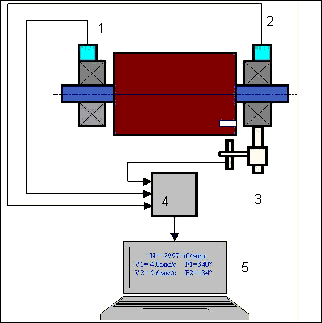
चित्र 6. बैलेंसेट-1 का उपयोग करते हुए, दो तलों में संतुलन के दौरान सेंसरों की स्थापना
1,2-vibration sensors, 3-phase, 4- USB measuring unit, 5-laptop
In most cases, dynamic balancing is carried out by the method of three starts. This method is based on the fact that test weights of an already-known mass are installed on the rotor in series in 1 and 2 planes; so the masses and the place of installation of balancing weights are calculated based on the results of changing the vibration parameters.
भार की स्थापना के स्थान को सुधार तल कहते हैं। आमतौर पर, सुधार तल का चयन बेयरिंग सपोर्ट के उस क्षेत्र में किया जाता है जिस पर रोटर लगा होता है।
प्रारंभिक कंपन को पहले स्टार्ट पर मापा जाता है। फिर, ज्ञात द्रव्यमान का एक परीक्षण भार रोटर पर किसी एक आधार के पास स्थापित किया जाता है। फिर दूसरा स्टार्ट किया जाता है, और हम कंपन मापदंडों को मापते हैं, जो परीक्षण भार की स्थापना के कारण बदल सकते हैं। फिर पहले तल में परीक्षण भार को हटाकर दूसरे तल में स्थापित किया जाता है। तीसरा स्टार्ट-अप किया जाता है और कंपन मापदंडों को मापा जाता है। जब परीक्षण भार हटा दिया जाता है, तो प्रोग्राम स्वचालित रूप से द्रव्यमान और संतुलन भार की स्थापना के स्थान (कोण) की गणना करता है।
The point in setting up test weights is to determine how the system responds to the imbalance change. When we know the masses and the location of the sample weights, the program can calculate the so-called influence coefficients, showing how the introduction of a known imbalance affects the vibration parameters. The coefficients of influence are the characteristics of the mechanical system itself and depend on the stiffness of the supports and the mass (inertia) of the rotor-support system.
For the same type of mechanisms of the same design, the coefficients of influence will be similar. You can save them in your computer memory and use them afterwards for balancing the same type of mechanisms without carrying out test runs, which greatly improves the performance of the balancing. We should also note that the mass of test weights should be chosen as such so that the vibration parameters vary markedly when installing test weights. Otherwise, the error in calculating the coefficients of the affect increases and the quality of balancing deteriorates.
Balanset-1 उपकरण के लिए दी गई गाइड में एक सूत्र दिया गया है, जिसकी सहायता से आप संतुलित रोटर के द्रव्यमान और घूर्णन गति के आधार पर परीक्षण भार का अनुमानित द्रव्यमान निर्धारित कर सकते हैं। जैसा कि चित्र 1 से स्पष्ट है, अपकेंद्री बल रेडियल दिशा में, यानी रोटर अक्ष के लंबवत कार्य करता है। इसलिए, कंपन सेंसर इस प्रकार स्थापित किए जाने चाहिए कि उनकी संवेदनशीलता अक्ष भी रेडियल दिशा में हो। आमतौर पर क्षैतिज दिशा में आधार की कठोरता कम होती है, इसलिए क्षैतिज दिशा में कंपन अधिक होता है। इसलिए, सेंसर की संवेदनशीलता बढ़ाने के लिए उन्हें इस प्रकार स्थापित किया जाना चाहिए कि उनकी संवेदनशीलता अक्ष भी क्षैतिज दिशा में हो। हालांकि इसमें कोई मूलभूत अंतर नहीं है। रेडियल दिशा में कंपन के अलावा, रोटर के घूर्णन अक्ष के अनुदिश अक्षीय दिशा में कंपन को नियंत्रित करना आवश्यक है। यह कंपन आमतौर पर असंतुलन के कारण नहीं, बल्कि अन्य कारणों से होता है, मुख्य रूप से कपलिंग के माध्यम से जुड़े शाफ्टों के गलत संरेखण और बेमेल होने के कारण। इस कंपन को संतुलन द्वारा समाप्त नहीं किया जा सकता है, इस मामले में संरेखण आवश्यक है। व्यवहार में, आमतौर पर ऐसे तंत्रों में रोटर का असंतुलन और शाफ्टों का गलत संरेखण होता है, जिससे कंपन को दूर करना बहुत मुश्किल हो जाता है। ऐसे मामलों में, पहले तंत्र को संरेखित करना और फिर उसे संतुलित करना आवश्यक होता है। (हालांकि, तीव्र टॉर्क असंतुलन होने पर, आधार संरचना के "घुमाव" के कारण अक्षीय दिशा में भी कंपन होता है)।.
माप सटीकता और त्रुटि विश्लेषण
पेशेवर संतुलन कार्यों के लिए माप सटीकता को समझना महत्वपूर्ण है। बैलेंसेट-1A निम्नलिखित माप सटीकता प्रदान करता है:
| पैरामीटर | सटीकता सूत्र | उदाहरण (सामान्य मानों के लिए) |
|---|---|---|
| आरएमएस कंपन वेग | ±(0.1 + 0.1×वीमापा) मिमी/सेकंड | 5 मिमी/सेकंड के लिए: ±0.6 मिमी/सेकंड 10 मिमी/सेकंड के लिए: ±1.1 मिमी/सेकंड |
| घूर्णन आवृत्ति | ±(1 + 0.005×एनमापा) आरपीएम | 1000 आरपीएम के लिए: ±6 आरपीएम 3000 आरपीएम के लिए: ±16 आरपीएम |
| चरण माप | ±1° | सभी गतियों पर निरंतर सटीकता |
⚠️ सटीक संतुलन के लिए महत्वपूर्ण
- !परीक्षण भार के कारण >20-30% आयाम परिवर्तन होना चाहिए और/या >20-30° चरण परिवर्तन
- !यदि परिवर्तन छोटे हैं, तो माप त्रुटियाँ काफी बढ़ जाती हैं
- !मापों के बीच कंपन आयाम और चरण स्थिरता 10-15% से अधिक भिन्न नहीं होनी चाहिए
- !यदि भिन्नता 15% से अधिक हो, तो अनुनाद स्थितियों या यांत्रिक समस्याओं की जाँच करें
संतुलन तंत्र की गुणवत्ता का आकलन करने के लिए मानदंड
Quality of rotor (mechanisms) balancing can be estimated in two ways. The first method involves comparing the value of the residual imbalance determined during the balancing with the tolerance for the residual imbalance. The specified tolerances for various classes of rotors installed in the standard आईएसओ 1940-1-2007. «कंपन. कठोर रोटरों की संतुलन गुणवत्ता के लिए आवश्यकताएँ. भाग 1. अनुमेय असंतुलन का निर्धारण".
हालाँकि, इन सहनशीलताओं का कार्यान्वयन न्यूनतम कंपन स्तर की प्राप्ति से जुड़े तंत्र की परिचालन विश्वसनीयता की पूरी गारंटी नहीं दे सकता। ऐसा इसलिए है क्योंकि तंत्र का कंपन न केवल उसके रोटर के अवशिष्ट असंतुलन से जुड़े बल की मात्रा से निर्धारित होता है, बल्कि कई अन्य मापदंडों पर भी निर्भर करता है, जिनमें शामिल हैं: तंत्र के संरचनात्मक तत्वों की कठोरता K, उसका द्रव्यमान M, अवमंदन गुणांक और गति। इसलिए, कुछ मामलों में तंत्र के गतिशील गुणों (इसके संतुलन की गुणवत्ता सहित) का आकलन करने के लिए, तंत्र के अवशिष्ट कंपन के स्तर का आकलन करने की सिफारिश की जाती है, जिसे कई मानकों द्वारा नियंत्रित किया जाता है।
The most common standard regulating permissible vibration levels of mechanisms is ISO 10816-3:2009 का पूर्वावलोकन: यांत्रिक कंपन – गैर-घूर्णनशील भागों पर मापन द्वारा मशीन कंपन का मूल्यांकन – भाग 3: 15 किलोवाट से अधिक नाममात्र शक्ति और 120 आर/मिनट से 15,000 आर/मिनट के बीच नाममात्र गति वाली औद्योगिक मशीनें, जब उनका मापन यथास्थान किया जाता है।»
With its help, you can set the tolerance on all types of machines, taking into account the power of their electric drive.
In addition to this universal standard, there are a number of specialized standards developed for specific types of mechanisms. For example,
- आईएसओ 14694:2003 "औद्योगिक पंखे - संतुलन गुणवत्ता और कंपन स्तरों के लिए विनिर्देश""
- आईएसओ 7919-1-2002 "अप्रतिवर्ती गति के बिना मशीनों का कंपन। घूर्णनशील शाफ्टों पर मापन और मूल्यांकन मानदंड। सामान्य मार्गदर्शन।""
🛡️ यूरोपीय संघ के अनुपालन के लिए महत्वपूर्ण सुरक्षा संबंधी विचार
- !जोखिम मूल्यांकन आवश्यक: परिचालनों को संतुलित करने से पहले EN ISO 12100 जोखिम मूल्यांकन करें
- !योग्य कार्मिक: केवल प्रशिक्षित और प्रमाणित कर्मियों को ही संतुलन संचालन करना चाहिए
- !व्यक्तिगत सुरक्षा उपकरण: हमेशा EN 166 (नेत्र सुरक्षा) और EN 352 (श्रवण सुरक्षा) के अनुसार उपयुक्त PPE का उपयोग करें
- !आपातकालीन कार्यवाही: स्पष्ट आपातकालीन शटडाउन प्रक्रियाएं स्थापित करें और सुनिश्चित करें कि सभी ऑपरेटर उनसे परिचित हों
- !दस्तावेज़ीकरण: पता लगाने और अनुपालन के लिए सभी संतुलन कार्यों का विस्तृत रिकॉर्ड बनाए रखें
यूरोपीय संघ के अनुपालन और सुरक्षा संबंधी जानकारी
अनुपालन की घोषणा
बैलेंसेट-1ए पोर्टेबल बैलेंसर निम्नलिखित यूरोपीय संघ के निर्देशों और मानकों का अनुपालन करता है:
| यूरोपीय संघ के निर्देश/मानक | अनुपालन विवरण | सुरक्षा आवश्यकताओं |
|---|---|---|
| मशीनरी निर्देश 2006/42/EC | मशीनरी और सुरक्षा घटकों के लिए सुरक्षा आवश्यकताएँ | जोखिम मूल्यांकन, सुरक्षा निर्देश, CE अंकन |
| ईएमसी निर्देश 2014/30/ईयू | विद्युत चुम्बकीय संगतता आवश्यकताएँ | विद्युत चुम्बकीय हस्तक्षेप के प्रति प्रतिरक्षा |
| RoHS निर्देश 2011/65/EU | घातक पदार्थों पर प्रतिबन्ध | सीसा-मुक्त, पारा-मुक्त, कैडमियम-मुक्त घटक |
| WEEE निर्देश 2012/19/EU | अपशिष्ट विद्युत और इलेक्ट्रॉनिक उपकरण | उचित निपटान और पुनर्चक्रण प्रक्रियाएं |
| EN ISO 12100:2010 | मशीनरी की सुरक्षा - डिजाइन के लिए सामान्य सिद्धांत | जोखिम मूल्यांकन और जोखिम न्यूनीकरण |
| एन 60825-1:2014 | लेजर उत्पादों की सुरक्षा - भाग 1 | कक्षा 2 लेज़र सुरक्षा आवश्यकताएँ |
| EN ISO 14120:2015 | गार्ड - सामान्य आवश्यकताएँ | घूर्णन मशीनरी के खतरों से सुरक्षा |
विद्युत सुरक्षा मानक
- ✓एन 61010-1: मापन, नियंत्रण और प्रयोगशाला उपयोग के लिए विद्युत उपकरणों की सुरक्षा आवश्यकताएँ
- ✓एन 60950-1: सूचना प्रौद्योगिकी उपकरण सुरक्षा (USB संचालित उपकरण)
- ✓आईईसी 61000 श्रृंखला: विद्युत चुम्बकीय संगतता मानक
- ✓ऑपरेटिंग वोल्टेज: 5V डीसी USB के माध्यम से (अतिरिक्त कम वोल्टेज)
- ✓बिजली की खपत: < 2.5W
- ✓संरक्षण वर्ग: IP20 (इनडोर उपयोग के लिए)
घूर्णन उपकरण सुरक्षा
⚠️ अनिवार्य सुरक्षा प्रक्रियाएं (EN ISO 12100)
चेतावनी: घूर्णनशील मशीनों के साथ काम करते समय, निम्नलिखित सुरक्षा आवश्यकताओं का पालन करें:
- !एन आईएसओ 14118: अचानक चालू होने से बचाव - सेंसर लगाने से पहले लॉकआउट/टैगआउट प्रक्रियाओं का उपयोग करें
- !ईएन आईएसओ 14120: सुनिश्चित करें कि सभी घूमने वाले उपकरण ठीक से सुरक्षित हों।
- !EN ISO 13857: घूमते हुए भागों से न्यूनतम सुरक्षित दूरी बनाए रखें (शरीर के लिए 500 मिमी, उंगलियों के लिए 120 मिमी)
- !व्यक्तिगत सुरक्षा उपकरण: EN 166 के अनुसार सुरक्षा चश्मे पहनें, EN 352 के अनुसार कान की सुरक्षा के लिए उपकरण पहनें और ढीले कपड़े पहनने से बचें।
- !गतिमान मशीनों पर कभी भी सेंसर या परीक्षण भार न लगाएँ
- !सेंसर स्थापना से पहले सुनिश्चित करें कि मशीन पूरी तरह से बंद और सुरक्षित है
- !आपातकालीन रोक: ऑपरेटर की स्थिति से 3 मीटर के भीतर पहुंच योग्य होना चाहिए
- !केवल योग्य और प्रमाणित कर्मियों को ही संतुलन संचालन करना चाहिए
लेजर सुरक्षा वर्गीकरण
🔴 क्लास 2 लेजर डिवाइस (EN 60825-1:2014)
- तरंगदैर्ध्य: 650 एनएम (लाल दृश्य प्रकाश)
- अधिकतम आउटपुट शक्ति: < 1 मेगावाट
- बीम व्यास: 100 मिमी की दूरी पर 3-5 मिमी
- विचलन: < 1.5 एमआरएडी
- सुरक्षा वर्गीकरण: क्षणिक जोखिम के लिए आँख सुरक्षित (< 0.25 सेकंड)
- आवश्यक लेबलिंग: ""लेजर विकिरण - किरण में सीधे न देखें - श्रेणी 2 का लेजर उत्पाद""
- प्रवेश वर्ग: अप्रतिबंधित (सामान्य प्रवेश की अनुमति)
लेज़र सुरक्षा प्रक्रियाएँ:
- कभी भी जानबूझकर लेज़र बीम में न देखें
- लेज़र को व्यक्तियों, वाहनों या विमानों पर लक्षित न करें
- ऑप्टिकल उपकरणों (दूरबीन, दूरबीन) से लेजर बीम देखने से बचें
- चमकदार सतहों से होने वाले परावर्तनों से सावधान रहें
- उपयोग में न होने पर लेज़र बंद कर दें
- आँखों के संपर्क में आने की किसी भी घटना की तुरंत रिपोर्ट करें
- लंबे समय तक एक्सपोजर के लिए लेजर सुरक्षा चश्मे (650nm पर OD 2+) का उपयोग करें
माप सटीकता और अंशांकन
| पैरामीटर | शुद्धता | अंशांकन आवृत्ति |
|---|---|---|
| कंपन आयाम | ±5% रीडिंग | सालाना या 1000 घंटे के बाद |
| चरण माप | ±1° | हर साल |
| घूर्णन गति | ±0.1% रीडिंग | हर साल |
| सेंसर संवेदनशीलता | 13 एमवी/(मिमी/से) ±101टीपी3टी | सेंसर बदलते समय |
पर्यावरण अनुपालन
- ✓परिचालन लागत वातावरण: 5°C से 50°C, < 85% RH गैर-संघनक
- ✓भंडारण वातावरण: -20°C से 70°C, < 95% RH गैर-संघनक
- ✓ऊंचाई: समुद्र तल से 2000 मीटर ऊपर तक
- ✓कंपन प्रतिरोध: आईईसी 60068-2-6 (10-500 हर्ट्ज, 2जी त्वरण)
- ✓आघात प्रतिरोध: IEC 60068-2-27 (15g, 11ms अवधि)
- ✓आईपी रेटिंग: IP20 (12 मिमी से अधिक ठोस वस्तुओं से सुरक्षा)
संचालन आवश्यकताएँ
- ✓ऑपरेटरों को यूरोपीय संघ के मानकों के अनुसार मशीनरी सुरक्षा में प्रशिक्षित होना चाहिए
- ✓उपयोग से पहले EN ISO 12100 के अनुसार जोखिम मूल्यांकन आवश्यक है
- ✓निर्माता के विनिर्देशों के अनुसार उपकरण का रखरखाव करें
- ✓किसी भी सुरक्षा संबंधी घटना या उपकरण की खराबी की तुरंत रिपोर्ट करें
- ✓पता लगाने की क्षमता के लिए सभी संतुलन कार्यों का विस्तृत रिकॉर्ड बनाए रखें
दस्तावेज़ीकरण आवश्यकताएँ
यूरोपीय संघ के अनुपालन के लिए, निम्नलिखित दस्तावेज़ बनाए रखें:
- ✓EN ISO 12100 के अनुसार जोखिम मूल्यांकन दस्तावेज़
- ✓ऑपरेटर प्रशिक्षण रिकॉर्ड और प्रमाणन
- ✓उपकरण अंशांकन और रखरखाव लॉग
- ✓दिनांकों, ऑपरेटरों और परिणामों के साथ संचालन रिकॉर्ड को संतुलित करना
- ✓सुरक्षा घटना रिपोर्ट और सुधारात्मक कार्रवाई
- ✓उपकरण संशोधन या मरम्मत दस्तावेज़ीकरण
तकनीकी सहायता और सेवा
तकनीकी सहायता, अंशांकन सेवाओं और स्पेयर पार्ट्स के लिए:
- ✓निर्माता: Vibromera
- ✓जगह: रुआ अल्काइड डे फारिया 193, पोर्टो, पुर्तगाल
- ✓वेबसाइट: https://vibromera.eu
- ✓सहायक भाषाएँ: सभी प्रमुख भाषाएँ उपलब्ध हैं। लिखित संचार की सुविधा उपलब्ध है।.
- ✓सेवा कवरेज: दुनिया भर में शिपिंग उपलब्ध है
- ✓वारंटी: खरीद की तारीख से 24 महीने
- ✓अंशांकन सेवा: अधिकृत सेवा केंद्रों के माध्यम से उपलब्ध